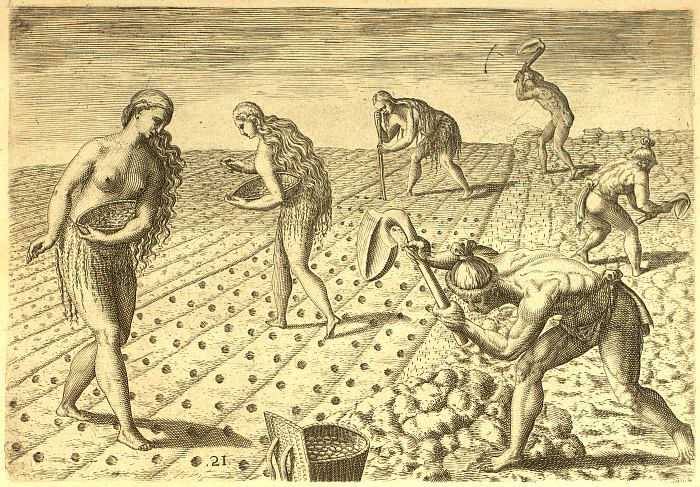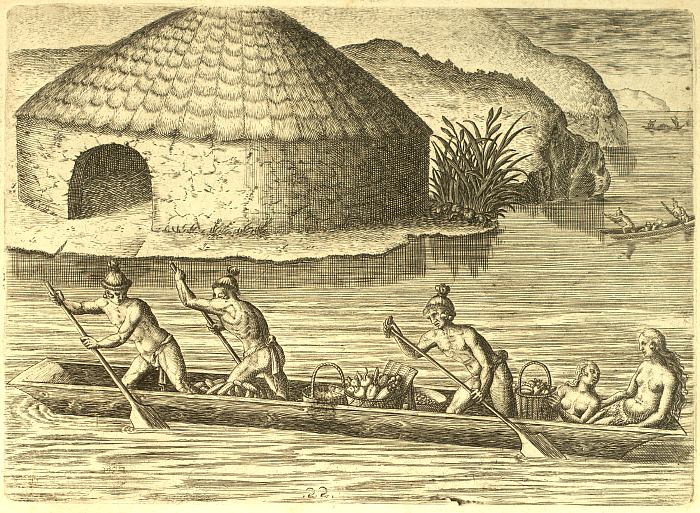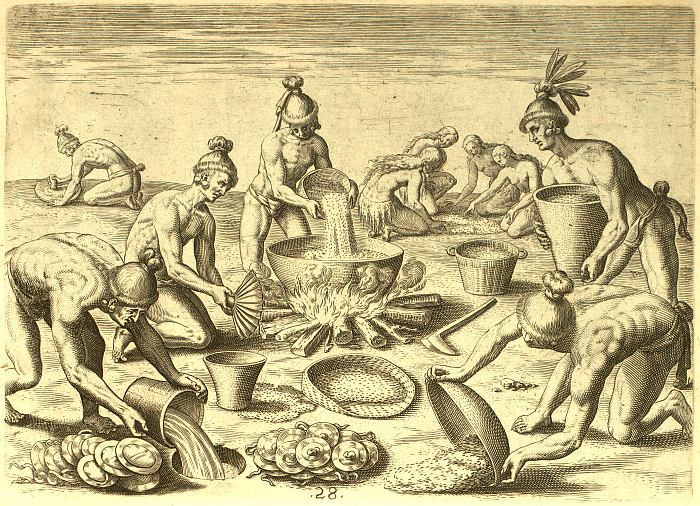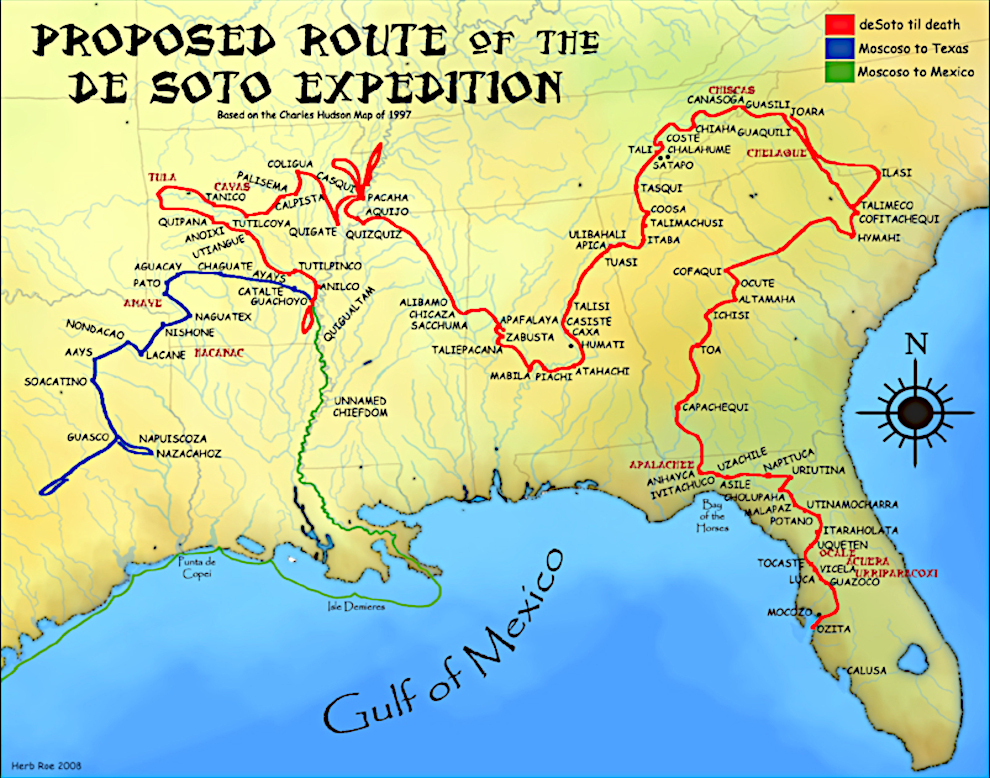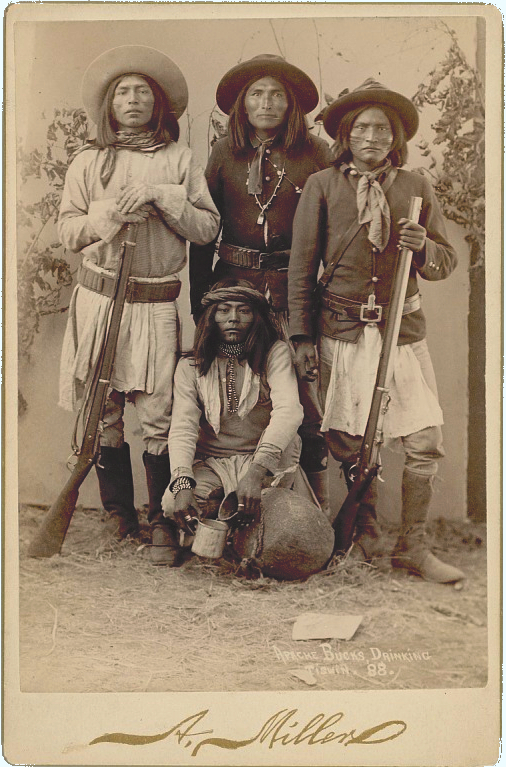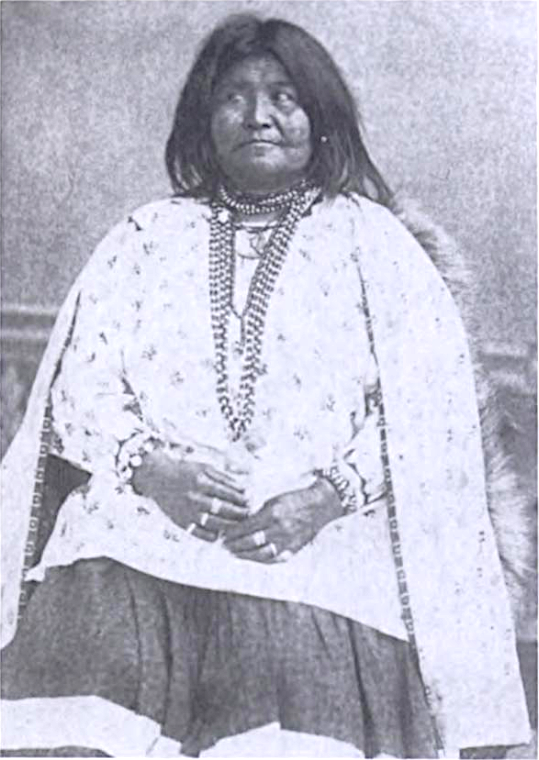The protohistory of beer in North America.
1 - The North American Brewing Basin and Native American Beers.
We follow for North America the protohistoric framework used for the other brewing basins of America and the world, namely :
- The primitive basis of the combined fermented beverages
- The rise of beers as stand-alone fermented beverages
- The stage where beer becomes the main cultural fermented beverage.
The protohistory of beer in North America (including Mexico) presents specificities and difficulties linked to the documents. As for the whole of the American continent, the life of its inhabitants is only known to us from 1492[1]. Year of first contact, year of catastrophe for the Amerindian peoples, year zero for the historiography of the continent. North America represents the most extreme case of this clash of civilizations. Whenever they set foot on North American soil, the Spanish, French, English and Dutch described peoples who were hunter-gatherers, sometimes farmers (the Three Sisters: corn, squash and beans, or grass and carob in the southwest). They did not find any highly hierarchical society similar to that of the Aztecs, Mayans or Incas.
The earliest accounts do not mention any fermented beverages in any region: northern Mexico, American Southwest, Florida, Mississippi, Canada, Carolina, etc. All describe peoples who drink water, psychotropic plant decoctions, and smoke tobacco. The myth of the Indian ignoring the effects of alcohol was born. It will have a long life.
Subsequent ethnological surveys and archaeological excavations have since revealed that Native Americans knew about fermented beverages long before the arrival of Europeans. They knew how to brew various kinds of traditional beers at least 6 centuries before the first contacts. These data, some of them very recent, reopen the question of the role of beer and the history of Native American brewing on the North American sub-continent.
The peoples of the Great Southwest are the most representative (Ancestral Pueblos, Zuňi, Hopi, Pima, Yuma, ...). Corn farmers since the 2th millennium c. n. era, they adopted beer as their main fermented beverage around the 10th century. Beer is part of their ceremonies and rituals. This fermented beverage belongs to their social life since a millenium at least.
But what about other North American peoples? Is the North American exception (missing fermented beverages) only apparent?
2 - The primitive basis of the combined fermented beverages.
Reconstructing the primitive basis of Amerindian fermented beverages in North America is a challenge. The ethnographic value of the oldest documents is low. From the 19th century onwards, the North American colonial enterprise changed its face: observations on the disappearing Amerindian peoples were compiled. However, the historical dimension is missing. The texts describe so-called Wilderness peoples, frozen in a kind of prehistory, without historical legacies or archaeological remains. Nevertheless, these compilations discover that the Amerindians knew fermented beverages made from fruits, agave or maple sap, berries, sweet juice from corn stalks, corn kernels, carob or goosefoot seeds. The oldest accounts of Spanish explorations bear witness to this, but do not refer to fermented drinks as such.
In 1540-42, Francisco Vázquez de Coronado set out to find a mythical city of Cibola. In the Mexican valleys of Sonora and Suya, along the Gulf of California, the Spaniards provide the oldest evidence of fermented beverage for North America, if we except central Mexico :
"The greatest festivals are on market days... At these times they all get drunk." and "They drink wine made of the pitahaya [the flower of cactus Hylocereus undatus], which is the fruit of a great thistle which opens like the pomegranate. The wine makes them stupid."[2]. Idem with the tunas, the fruits from the cactus Opuntia.
“The pitahaya is a giant cactus found on the high tablelands of the Gila and on most of the high plains of this whole region. It bears a fruit about the size of a hen’s egg, green in color, tinted whit red. When ripe, the fruit bursts, exposing a pulp of mawkish taste. The sun dries this to about one-third its size, when it drops out of its covering. It is then of the consistency of a dried fig. The Pimas and some other Indians collected these pulps which they rolled into balls and boiled to the consistency of molasses. The fruit and its juice were also fermented in various way for beverage purposes. "[3]
The Pima made tesvino from maize, and sometimes mescal, or sourced sotol from Mexico (La Barre 1936, 232. See Biblio). The peoples Tohono O'odham, Piman, Apache and Maricopa all used the cactus Saguaro to produce a wine, sometimes called tiswin or haren a pitahaya. The fruit of several species of Opuntia, including 0. Tuna Mill. and 0. Ficus-Indica Haw., was also used by the Indians of Mexico to make an intoxicating beverage, called colonche, which is pink in colour and tastes like raw cider. The Coahuiltecan who inhabited the Rio Grande Valley combined mountain laurel with agave sap to create an alcoholic drink similar to pulque. Wild honey is also used to make mead. The Amerindians of the Great Southwest know how to prepare alcoholic beverages with anything that ferments spontaneously.
There are scant observations of fermented fruit drinks, aloes, maguey, pigtails, of pitaya, of wild grapes or berries along the Pacific coast, of maple sap in Canada, of maize among the Huron of Lake Ontario or the Muskogee and Cherokee of Appalachia.
Testimonies from the 18th and 19th centuries describe a set of non-specialised fermented beverages whose making is conditioned by the logic of gathering. Depending on the season and the ecosystem, the Amerindians ferment fruits, cactus sap, seeds or honey. Drinks are made from the mixture of everything that can be fermented at one time of the year. Beer is not a stand-alone drink.
The agriculture of the Three Sisters coexists with plant gathering and hunting since the widespread cultivation of maize throughout most of the North American subcontinent. The result is a patchwork of peoples and highly varied social organisations adapted to their environments that is formed between the 10th and 16th centuries. Maize and agriculture do not appear to have played a dominant role. A large majority of the North American territory seems to lack traditional fermented beverages in modern times.
What historical value can be ascribed to these scattered testimonies? The historical reconstructions based upon them remain vague and fragmentary. They are built with very heterogeneous linguistic, archaeological and historical data.
Fortunately, archaeology provides a historical depth that counterbalances this flat view of the past of North American Indian societies.
3 - The rise of beers as stand-alone fermented beverages.
The issue is summarised by Valery Havard in 1896 :
"The cultivation of Maize, as we know, spread rapidly northward from Mexico, so that even before the days of Columbus it was the principal crop of all the agricultural Indians from the Rio Grande to the St. Lawrence and from the Atlantic to the Colorado of the West. Considering the abundance of corn among our Indians, and their craving for all intoxicants, it seems almost incomprehensible that the primitive and very simple art of making corn beer should never have found its way north of the Rio-Grande."[4].
Havard reduces the range of Native American beers to maize beer. North American researchers are obsessed with Andean maize chicha and often ignore or neglect beers brewed with other starchy plants. Native Americans also know how to brew beer with carob seeds or with starchy roots such as sweet potato, cassava or wapato, the Indian potato.
The role of maize and farming.
Maize is a plant indigenous to the American continent, domesticated about 5000 years ago in central Mexico. A millennium later, maize cultivation spread to the tropical regions of Central and South America. A variety of maize known as Northern Flint, with an ear of barely 5 cm, was cultivated in the American Southwest around 2100 BC (Rocky Mountains, Mesa Verde). This technique and associated plants (squash, beans) were passed down from central Mexico to present-day Arizona and New Mexico, which are more arid than the region of origin of the maize that adapted.
The cultivation of maize is attested to around 800-1000 in the centre (Missouri, Mississippi) and around 900 in the eastern part of the subcontinent (Appalachia)[5]. Maize was present on the shores of Lake Ontario around 900-1000. Its northernmost limit is reached on the banks of the St. Lawrence River around 1400. People of Iroquoian and Mandan culture adopted it and made it their main starchy food.
The study of fossil skeletons shows that the share of maize in the diet increased significantly around 1000-1300 for the American Indians of Massachusetts, Illinois, Ohio, and West Virginia[6].
The other starchy plants.
Everywhere, maize cultivation is associated with beans and squash. Beans have been grown in North America for as long as maize varieties, as have sweet potatoes and cassava in the south of the subcontinent. Carob trees (Prosopis, mesquite bean) native to the American Southwest have provided an important starch resource from pod harvesting. This has been used to brew beer in the American Southwest. To this list should be added other plants native to the Southwest such as chenopods, gourds, the drought-resistant Tepary bean. The wapato (Indian potato, Sagittaria latifolia), which Louis Nicolas identified in 1664-1675 and named by its Iroquois name ounonnata, can be found in the north and south of the subcontinent. This aquatic plant native to North America produces starch-rich rhizomes, an essential food resource for Native Americans who collect it in autumn and winter. Some species of sarsaparilla (Smilax) with starchy roots have been used to brew beer in Canada, although it is not known whether this beverage existed prior to colonisation[7].
Literature reports in the 19th century that Native Americans brewed cassava, sweet potato and carob beers in the Southwest and Southeast. A century after Valery Havard, North American researchers reiterate the problematic absence of fermented beverages in North America before the first contacts, especially among the Appalachian and Mississippi peoples, who were among the most advanced societies in North America between 800 and 1600 :
"First contact with Europeans occurred in 1513 when Juan Ponce de Leon discovered Florida. There is only limited evidence that alcoholic beverages existed prior to White contact, but there was no lack for ingredients; the south-eastern tribes agricultural life style was an ideal setting for the production of alcohol. There is also conjecture that Indians from Mesoamerica may have made early contact with tribes along the Mississippi Valley; this could have occurred by sailing across the Gulf of Mexico (Josephy, 1991). If this had taken place, Mesoamerican Indians may have exchanged their knowledge of producing alcohol..." [8]
The beer of the Ancestral Puebloans.
The Ancient Pueblos of Chaco Canyon brewed maize beer before any contact with European settlers. Three shards discovered at Pueblo Bonito in 2006 and dated between 800 and 1100 (1 spotted bowl from the Mogollon 1 cylindrical jar, 1 pitcher with black/white decoration), bear traces of organic compounds comparable to those of Tarahumara beer pottery (Northern Mexico)[9]. In 2007, characteristic traces of fermentation (pitting and microperforations on the inner walls of vessels) were observed on sherds from Ancestral Puebloan sites in New Mexico but not analyzed.
A more recent research conducted in 2016 at Casas Grandes (site of Paquimé, Chihuahua State, Mexico) on the teeth of skeletons exhumed during excavations in the 1950s-60s revealed starch granules and maize phytoliths fossilized in tartar. The starch granules show the characteristic deformations of alcoholic fermentation (swelling, striations) that can be observed under an electron microscope and polarised light.
Most interestingly, the 110 skeletons whose teeth were studied were buried at Casas Grandes between 700 and 1450, the period of development and expansion of the sites in the Casas Grandes valley. However, traces of fermented maize do not appear on the teeth until around 1200 (Medio Period de Casas Grandes). The adoption of fermented grain-based beverages coincides with a major social change that impacts on the subsistence economy[10].
"Turning maize into beer during the Medio period, however, could suggest an influx of new ideas — or perhaps even people — during that time, which might indicate outside influence — either foreigners coming to Casas Grandes, or locals traveling and coming back with new ideas." (David King 2016)
The 12th century appears to be a pivotal period for the Great American Southwest. Developments spread from central Mexico. Casas Grandes becomes in the 14th century a city housing about 3,000 people, a trading post between central Mexico and the Southwest, a centre of political power and the nucleus of a hierarchical society. The historical details of these local developments are still very unclear, as are their impacts on Native North American societies.
The study of the spatial and chronological distribution of drinking ceramics at the site of Pueblo Bonito (Chaco Canyon, New Mexico) since 900 has shown that the shape of the vessels varies according to time, the nature of the beverages, and the social status of drinkers[11]. The oldest vessels (600-700) imitate vegetable gourds. The frequency of pitchers and cylindrical jars between 900 and 1100 indicates a period when fermented beverages and cocoa from central Mexico played a major role in social life, ritual and exchange. Analysis of the cylindrical jars indicates that they were used to prepare and drink caffeinated beverages such as chocolate or black drink. Around 1100, the cylindrical jars disappeared and were replaced by smaller jars for various drinks including maize beer. Casas Grandes does not tell us when maize beers appeared in the region, but when they played a predominant role in the organisation of the Amerindian societies of the area and in their religious complexes.
|
2000 BC |
? |
300* |
≈1000 |
1600 |
|
Three Sisters Agricultural Complex
|
Emergence of the maize beer |
The place of beer is strengthened by the economic role of maize |
Maize beer tied to elites and religious complexes |
Shock of colonisation |
|
Primitive basis of the mixed fermented beverages |
Maize beer emerges as a distinct beverage among the others fermented beverages |
Beer stands out from other fermented beverages (wine, mead) |
Maize beer becomes the main fermented beverage |
Political Spanish domination and social regression |
|
* Beginning of the Mogollon culture, a symbolic date without material evidence regarding the growing rôle of maize beer. |
||||
These data converge to tentatively fix the time when maize beer became one of the main fermented beverages in northern Mexico and the American Southwest, that is around the 10th century. There is a great chronological gap between the adoption of the Three Sisters agriculture in the region around 2000BC and this central role played by the maize beers. Mead, maguey (pulque), tunas and fruit wines have been prepared and incorporated into ceremonies since the Classic period (300-600) of ancient Mexico, and probably earlier. Maize beers emerged or separated from other primitive fermented beverages at an unknown time. This chronological gap confirms that the mechanisms which give beer a central function are not only technical (maize cultivation, pottery, fermentation) but also social-economic (hierarchy, social segmentation, consolidation of political power) and religious (fertility rites, priesthood of priests specialised in collective rituals). Beer-Studies for a detailed discussion of the protohistory of the world's brewing pools. These three factors in combination account for the fact that two millennia separate the first Three Sisters-based agricultures and the prevalence of maize beers in Southwestern Native American societies. The later stages of this evolution have been studied on the basis of archaeological, linguistic and ethnological data.
Two likely routes have spread from northern Mexico a set of social practices and techniques: the cultivation of the Three Sisters and associated techniques (irrigation, feeding, beer brewing), the religious complexes associating food plants, fertility/rain rites, and annual cycles. These new practices have been integrated with the old ones: maize beer does not make pulque, mead and other fermented drinks disappear[12].
The beer of the Zuňi Indians.
Archaeology suggests that the Zuňis have inhabited their current location, the Zuni River Valley, for almost 3000 years. In that time, the ancestral Zuni people irrigated tiny plots of land to grow maize and other associated crops. How long have they been brewing maize beer? Since the 8th century at least according to the Pueblo Bonito data, but certainly earlier with the evolution of the Mogollon culture between the 3rd century and the 15th century[13].
The Zuňi brewing tradition has not been interrupted since the 12th century, when it was supposedly introduced from Mexico or when maize beers were first invented in the American Great Southwest. Zuňi communities have a relatively complex social structure and highly sophisticated annual ceremonies. One of these celebrates Mother Earth, fertility and the coming of the maize that sustains the material existence of the Zuňi. The hla'hewe ritual is performed every four years in August, when the maize is a foot high, in order to praise the rain and the maize and to bring them in abundance. It is a fertility rite. These rites are accompanied by the brewing of maize beer and its ritual collective consumption. The brewing techniques documented in the 19th century show that maize beer became the main fermented drink. It is a stand-alone drink, separate from other fermented beverages and the object of advanced technology in the hands of women.
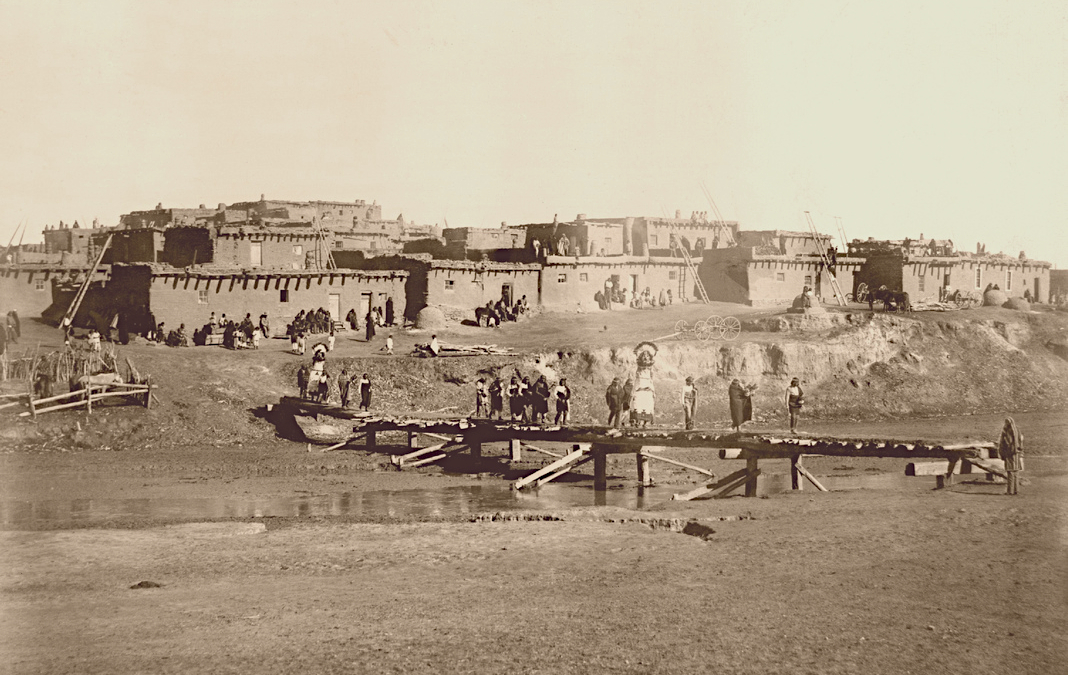 |
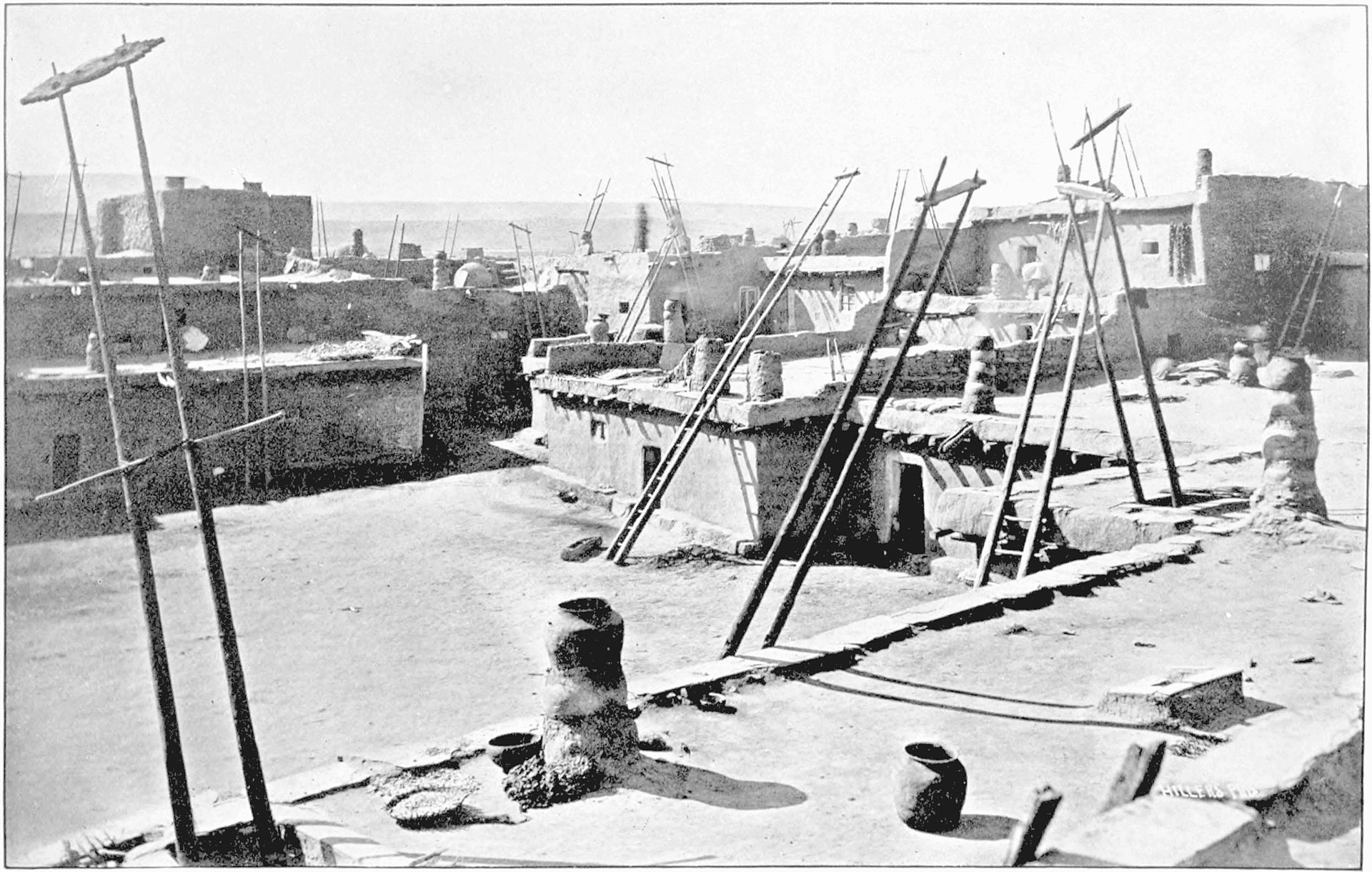 |
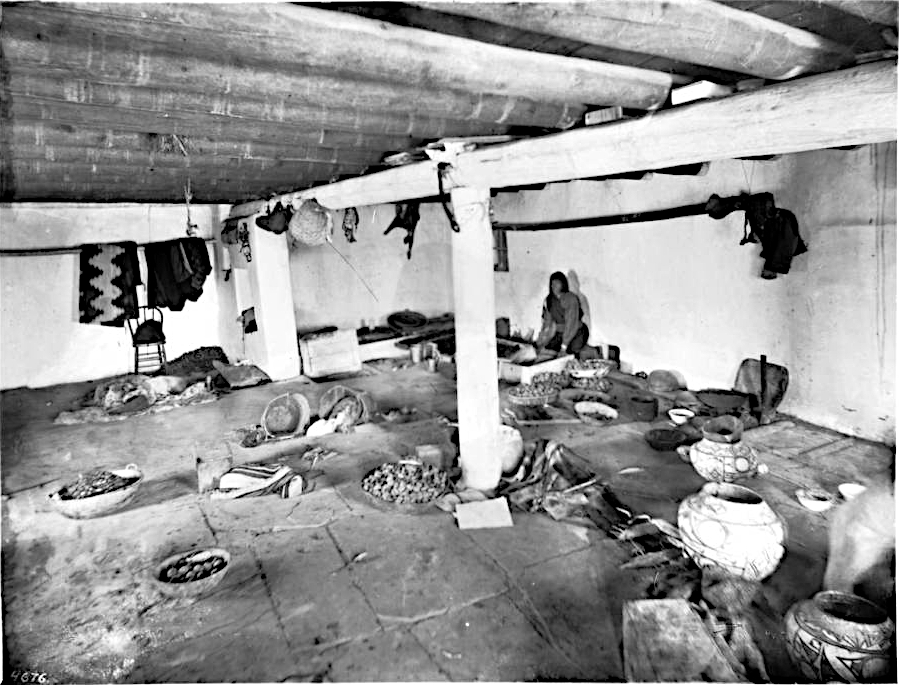 |
| A Zuñi village in New-Mexico, photo by Ben Wittick 1897. | On the terraces of a Zuñi village around 1920. | Interior of a Zuñi village house showing the various uses of domestic pottery (1898). |
Zuňi women mastered the malting of maize: moistening the kernels, germinating in the sun, and milling the germinated maize. Matilda Coxe Stevenson has detailed the main steps in 1908:
"Ta´kuna kiu’we (‘bead water’) is made of popped corn (Ta´kunawe) ground as fine as possible. The powder is put into a bowl and cold water is poured over it. The mixture is strained before it is drunk. While this beverage may be drunk at any time, it is used especially by the rain priests and personators of anthropic gods during ceremonials. A native drink which the Zuñi claim is not intoxicating is made from sprouted corn. The moistened grain is exposed to the sun until it sprouts; water is then poured over it and it is allowed to stand for some days."[14]
This ethnologist gave precise descriptions of the brewing technology of the Zuňi. Her inventory of starchy plants used goes far beyond maize, wheat (introduced by the Spanish) and beans. The Zuňi also use the roots of Euphorbia serpyllifolia to prepare a saccharifying paste in the following manner:
"The root, which is generally gathered by the men and carried to the female members of the family, to whom it properly belongs, is broken into bits and preserved in sacks. After the mouth has been thoroughly cleansed, a small piece of the root is placed therein by each of the women who are to make the sweetening for corn-meal he’palokia. The root remains in the mouth two days, except when removed to enable the woman to take refreshment and to sleep. Each time the mouth is cleansed with cold water before the root is returned thereto. The root is finally removed when the process of sweetening the corn meal is begun.” The insalivated pieces of root are able to convert starch into fermentable sugars using the salivary enzyme ptyalin. The same technique is used with maize flour:
"Either yellow or black corn is used, according to taste. The corn is freshly and finely ground. With her fingers the woman puts as much meal into her mouth as it will hold. The meal is not chewed, but held in the mouth until the accumulation of saliva forces her to eject the mass, which is deposited in a small bowl. This process is continued until the desired quantity of chi´kwawe (pl.), ‘sweetening,’ has been prepared for the he’palokia. To a great extent sprouted wheat has taken the place of corn meal for sweetening he’palokia, but for this purpose the wheat is never taken into the mouth.” (Coxe Stevenson, 68). The technique of brewing by insalivation can therefore be replaced by malting the wheat grains. This is the first step. Afterwards the insalivated pellets or the maize malt are mixed with raw maize flour to brew beer:
"Sprouted wheat is used for making he’palokia which consists of a small quantity of the wheat ground and mixed with a batter made of wheat flour. Fragments of dried he’palokia, ground as fine as possible in a mill and mixed with water, constitute a beverage which is enjoyed by the Zuñi.” (Coxe Stevenson, 71). This beverage is maize beer, which the Zuňi call ta kuna kiuwe ("pearl water"). The same basic preparation (maize or wheat flour + insalivated pellets or maize malt) is used to bake leavened bread (mu'loows) or to let this saccharified dough ferment with water to make beer. Yeast is brought in by the clay vessels. Zuňi women are expert potters.
These three brewing methods, the arguably older insalivation, the amylolytic ferment (he'palokia) and malting, are a historical compendium of the technical developments experimented with by the Zuňi over the centuries. They also tell of the antiquity of beer brewing among the Zuňi peoples who were able to exploit all the plant resources of their environment, including wheat introduced by the Spanish around the 17th century.
The carob beer of the Yumas, Pimas, Maricopas, Tumas and Apaches Amerindians.
Carob beers are the traditional fermented beverages of the California Amerindians (Yuma, Pimas, Maricopas, Tumas, Apaches). They are already attested by the Spanish expeditions of the 16th century.
The Spanish expedition led by Pánfilo de Narváez between 1527 and 1528 to colonise Florida suffered a dramatic failure. Only 4 survivors reached Mexico in 1536 after crossing the region inhabited by the ancient Pueblos. One of them, Álvar Núñez Cabeza de Vaca, describes their way of preparing carob seeds to make flour to be diluted in water, with the eventual fermentation of a drink:
"They gave us a great quantity of the flour of mezquiquez. The fruit while hanging on the tree, is very bitter and like unto the carob; when eaten with earth it is sweet and wholesome. The method they have of preparing it is this: they make a hole of requisite depth in the ground, and throwing in the fruit, pound it with a club the size of the leg, a fathom and a half in length, until it is well mashed. Besides the earth that comes from the hole, they bring and add some handfuls, then returning to beat it a little while longer. Afterward it is thrown into a jar, like a basket, upon which water is poured until it rises above and covers the mixture. He that beats it tastes it, and if it appears to him not sweet, he asks for earth to stir in, which is added until he finds it sweet. Then all sit round, and each putting in a hand, takes out as much as he can. The pits and husks are thrown upon a skin, whence they are taken by him who does the pounding, and put into the jar whereon water is poured as at first, whence having expressed the froth and juice, again the pits and husks are thrown upon the skin. This they do three or four times to each pounding. Those present, for whom this is a great banquet, have their stomachs greatly distended by the earth and water they swallow. The Indians made a protracted festival of this sort on our account, and great areitos [areitos[15]] during the time we remained."[16]
It is difficult to identify the brewing of a carob beer from this description. Yet it is. This brewing technique is attested to in the 19th century among the Native Americans living along the Colorado and upper Rio Grande. Did it already exist in the 16th century? No doubt. The ancient Pueblo and Hopi are sedentary, agriculturalists and have inhabited this semi-desert region since the beginning of the 1st millennium. They brew maize beer, a fermented beverage valued in their rituals. Carob pods are both a daily food and a substitute for maize in times of famine or hunger between annual maize harvests. Making beer from them is a result of the severe agricultural constraints on Pueblo and Hopi societies.
“The Mezquite (Prosopis Juliflora DC.) or the screw bean, "tornillo" (Prosopis pubescens Benth) are by far the most common trees or shrubs of the immense desert tracts drained by the Rio Grande, Gila and Lower Colorado, as it is the most useful to their inhabitants, supplying both food and fuel. The fruit is a bean-like pod containing more than half its weight of nutritive principles, especially sugar in the proportion of 25 to 30 per cent. and mainly starch; when cooked, pounded, mixed in water and strained, it yields a very nutritive and pleasant beverage called "atole"; this readily undergoes fermentation whereby a kind of beer is produced, formerly much used by the Colorado and Gila River Indians."[17]
In 1849, the California Gold Rush brought together American settlers and Native Americans who had survived the massacres committed by the trappers and the army. One of the routes to California passed through the confluence of the Colorado and Gila rivers, in the middle of the Yuma territory. The Yuma grow maize and gather carob pods, which are abundant in the semi-desert areas of the Great Basin and Upper California. The carob seeds are used to brew beer:
“The Aborigine at the junction of the Gila and Colorado rivers as well as those on Tiburon Island has a curious custom in connection with the mesquite liquor. Mesquite pods were steeped in water and left to ferment. The natives chewed them, swallowed the liquor absorbed, and then spat them back into the fermented liquid. These pods were chewed over and over again, and by different persons, often as many as 20 or 30 times."[18]
The Yuma tribe, also known as the Quechan, lived in the states of California and Arizona along the Colorado River. The Yuma tribe fiercely resisted the invasion of their homelands and fought against the US in the Yuma War (1850–1853). The name of the most famous chief of the Yuma tribe was Chief Pasqual. In 1890 Dr. W.E. Ferrebee, a special agent to the Indians, reported that "a very acceptable beverage, called pissioina, was prepared by the Yuma by roasting wheat grains over a charcoal fire until they assumed a light-brown color, after which they were pulverized, dissolved in water, and allowed to ferment before drinking."[19]. Since wheat was not a Native American grain, it was concluded that this pissioina beer was an imitation of the beers made by European settlers, not an authentic indigenous beer. By 1890, the Yuma, reduced to about 1,000 individuals, were confined to reservations, deprived of farmland and fed bi-weekly rations from the US army, including wheat. Without the ability to grow maize or pick carob pods, the Yuma replaced them with wheat to brew their beer.
Carob beers appear to have been brewed over a wider area from Texas to New Mexico:
"Pods contain pulpy sweet nutritious material; whole pods ground and made into bread and cakes, or mush and porridge; used also for making sweet drink (atole) or fermented to beer; Texas, New Mexico, and Arizona."[20].
The travel diary of Francisco Garcés, a Franciscan missionary who travelled between 1770 and 1776 in Arizona and California, mentions the atoles de semillas of the Amerindians living in these areas, which were half drink and half porridge: "for it was a profusion of watermelons, muskmelons, corncakes (panes de maiz), gruels of seeds (atoles de semillas), and fish that they presented to me.”[21]
The cassava and sweet potato beers of the Southeast Indians.
Huguenots attempted to colonize Florida between 1562 and 1565 and lived there alongside Native Americans Timucuas, Potanos, Saturiwas and Tacatacuru. Their diet is based on the cultivation of maize, tubers, fishing and hunting. No mention of fermented drinks. Laudonnière incidentally mentions cassava and sweet potato, products traded on the Florida coast with Caribbean islands such as Cuba or the Bahamas. Cassava roots:
« … the boat having taken the traicte of the coast [skirting the east coast of Florida]... took, near the place called Archala, a brigantine loaded with some cassana, which is a kind of bread that is made of roots, and nevertheless very white and good to eat, and some wine. »[22]. Another starchy root grown inland : cassava or sweet potato? "There was an island situated in a large fresh water lake called Serropé, about five leagues long, fertile in several kinds of fruits, principally dates, which come from palms, of which they make a marvellous traffic, however not so great as from a kind of root, from which they obtain a flour so suitable for making bread, that it is impossible to eat a better one, and the whole country fifteen miles around is fed with it, which is why the inhabitants of the island attract great wealth from their neighbours; for one can only barter this root for good stuff, moreover they are held to be the most warlike men in the world." (Laudonnière 1564, 133)
At that same period, the Carib peoples used these tubers to brew beers. In particular, they brewed a sweet potato beer called mabi (or mapi). Surprisingly, the Native Americans of Florida did not adopt this technique, to our knowledge.
From the very first contacts, the English colonists became acquainted with the three main starchy plants of the Amerindians: maize, sweet potato and manioc. The Amerindians made pancakes from them, which the colonists paired with bread and thick soups that could ferment. But here again, the boundary between liquid beer and fermented soup was not familiar to the settlers. Thomas Harriot, an English polymath, landed on the Virginia coast in 1587 with 110 colonists. This knowledgeable observer described the use of the three main North American starch crops: maize, sweet potato and manioc.
The maize: "Pagatowr, a kinde of graine so called by the inhabitants; the same in the West Indies is called Mayze: English men call it Guinney wheate or Turkie wheate, according to the names of the countreys from whence the like hath beene brought. The graine is about the bignesse of our ordinary English peaze and not much different in forme and shape: but of diuers colours: some white, some red, some yellow, and some blew. All of them yeelde a very white and sweete flowre: beeing vsed according to his kinde it maketh a very good bread. Wee made of the same in the countrey some mault, whereof was brued as good ale as was to bee desired. So likewise by the help of hops therof may bee made as good Beere."[23]
So no corn beer brewed by the Indians according to Thomas Harriot's report, at least in the guise of a liquid drink! The situation is alike with the uses of sweet potatoes:
"Tsinaw a kind of roote much like vnto the which in England is called the China root brought from the East Indies. And we know not anie thing to the cõtrary but that it maie be of the same kind. These roots grow manie together in great clusters and doe bring foorth a brier stalke, but the leafe in shape far vnlike; which beeing supported by the trees it groweth neerest vnto, wil reach or climbe to the top of the highest. From these roots while they be new or fresh beeing chopt into small pieces & stampt, is strained with water a iuice that maketh bread, & also being boiled, a very good spoonemeate in maner of a gelly, and is much better in tast if it bee tempered with oyle. This Tsinaw is not of that sort which by some was caused to be brought into England for the China roote, for it was discouered since, and is in vfe as is aforesaide: but that which was brought hither is not yet knowne neither by vs nor by the inhabitants to serue for any vse or purpose; although the rootes in shape are very like."
The situation is somewhat clearer with cassava. The making of sour cakes with cassava flour provides a possibility of alcoholic and lactic fermentation when the cassava loaves are soaked in water:
"Coscúshaw, some of our company tooke to bee that kinde of roote which the Spaniards in the West Indies call Cassauy [cassava], whereupon also many called it by that name: it groweth in very muddie pooles and moist groundes. Being dressed according to the countrey maner, it maketh a good bread, and also a good sponemeate, and is vsed very much by the inhabitants: The iuice of this root is poison, and therefore heede must be taken before any thing be made therewithal: Either the rootes must bee first sliced and dried in the Sunne, or by the fire, and then being pounded into floure wil make good bread: or els while they are greene they are to bee pared, cut into pieces and stampt; loves of the same to be laid neere or over the fire untill it be soure, and then being well pounded againe, bread, or sponemeate very good in taste, and holsome may be made thereof."[24]
4 - Was an Ameridian beer brewed everywhere in North America?
The Appalachian mazamorra from maize in 1639.
Hernando de Soto leads a new expedition to conquer Florida in 1539. In the Appalachians he encounters developed Amerindian societies with a political hierarchy. The caciques received quotas of maize, skins and cotton from the other subjugated Amerindian tribes. The huge Spanish column passed through landscapes covered with maize fields and wintered in 1539-40 among the Apalachee Indians in the walled city of Anhaica, which had 250 buildings. Its population is estimated at 30,000, that of its province at about 60,000. The Amerindians serve the Spaniards a porridge of maize flour sweetened with sugar or honey that the Spaniards call mazamorra. It is a perfect base for a thick fermented drink. Spanish authors used to separating solid food and liquid drink do not call this mazamorra a drink: "In the last few days, since they left Tali, the cacique of Tali has had maize, mazamorra, baked beans and whatever else he could bring [by the Indians] from their towns along the road"[25]. These same Spaniards name mazamorra a porridge but also a beer brewed by the Nicarao and Chorotega of Nicaragua with ground maize and honey. The term mazamorra is given by Oviedo y Valdés in 1526 with this double meaning[26]. Rodrigo Rangel's account was co-authored with Oviedo y Valdés, who incorporated it into his Historia general y natural de las Indias (L. XVII, cap. 21-28). The mazamorra of Appalachia may be related to the sofkee (or osafke) of the 18th century Muskogee and Cherokee, a sour maize drink possibly fermented.
The Huron's beer in the 17th century.
The Huron brew a type of maize bread-beer that is rarely described as a beer but rather as a fermented bread. The Huron-Wendat inhabited the shores of Lake Ontario in the 16-17th centuries. Gabriel Sagard stayed among them in 1623-24 and describes one of three ways of preparing maize:
"They make bread of another kind, that is, they pick a quantity of wheat [maize], before it is completely dry & ripe, then the women, girls & children with their teeth detach the grains from it, which they then throw back with their mouths into large bowls which they hold near them, & then they finish pounding it in the large Mortar: & for this dough is very mushy, it is necessary to wrap it in sheets to cook it under the ashes as usual; this chewed bread is the most esteemed among them, but for me I only ate it by necessity & reluctantly, because the wheat had been thus half-chewed, pounded & kneaded with the teeth of the women, girls & small children. »[27].
Chewing soft maize kernels is an ancient way of saccharifying the starch with saliva. Making balls of corn wrapped in maize leaves accelerates alcoholic and acetic fermentations. The superficial cooking under the ashes should leave the heart of these maize balls still moist and fermented. Can we talk about beer? No, because these half-baked balls of maize are consumed like bread and not like a drink. Yes, because the technical process is similar to that of beer breads in European, Asian or African antiquity. On the other hand, the same Sagard praises the abstinence of the Hurons (op. cit. 144-146). But we know this one was only relative, the vision of a missionary. The Hurons drank the distilled spirits of French or English trappers. Sagard also describes the preparation of the stinking maize or indohy which is also linked to the beer topic:
"For the indohy or stinking wheat, these are great quantities of ears of wheat, not yet quite dry and ripe, to be more susceptible to smell, which the women put in some pool or stinking water, for the space of two or three months, at the end of which they take them out, & this serves to make feasts of great importance, cooked like Neintahouy, & also eat some roasted under hot ashes, licking their fingers at the handling of these stinking ears, as if they were sugar canes, though the taste and smell of them is very pungent, & more foul than the sewers themselves are, and this wheat thus rotten was not my meat, however much they esteemed it, nor did I gladly handle it with my fingers or hand, for the bad smell it imprinted on it and left for many days." (Sagard 1632, 140-141).
Sagard describes a fermentation of the whole maize cobs pushed to the extreme, followed by cooking to remove all traces of alcohol, and a consumption as a porridge (Neintahouy). This fermented maize is not consumed as a drink. The fact remains that the fermentation of grains, their decomposition, is known and appreciated by the Huron. There is a thin line between the alcoholic fermented and the rotten states[28].
The Native American beers would have existed up to a northern boundary that is difficult to trace, stretching from Connecticut to Dakota, bordering the great forests of the Canadian plateau and the Great Lakes. The historical reality of this boundary is problematic. The case of the Huron is emblematic. They lived in the 17th century west of Lake Ontario and prepared fermented maize cobs that bore no resemblance to the image that Europeans had of a beer and that is not described as such by them. This Huron "stinking beer" sums up the difficulty of the North American dossier: very fragmentary data, interpretive hardships, and no (proto)historical dimension.
The Muskogee's and Cherokee's maize beer in the 18th century.
Some late accounts from the late 18th century present Muskogee (Creek) sagamity as a fermented drink of maize. Jean-Antoine Leclerc de Milfort joined the powerful Creek confederacy in 1776 in a latent war with the American settlers of the East Coast and the Spaniards of Florida who were cornering its territories east of the Mississippi (present-day Alabama). He adopts its customs and language, and tells how the Creek receive their guests:
"They received us [the Osages] with marks of great satisfaction, and immediately on our arrival gave us cooked meat and sagamite (1). My people, who had not drunk sagamite for nearly a year, were very satisfied with this reception, to which they did great honour by the quantity of this liquor they consumed.". Note (1) written by Milfort himself explains "Sagamité is a kind of beverage made from maize flour."
Further on, Milfort states:
"It was about noon, and I saw the chiefs being served roasted meats, bread, and sagamite, a drink of which they make great use (1)". Note (1) reads "Sagamité is a fermentation made with maize flour, which, after being boiled, retains a rather pleasant cider taste."[29] (Milfort 1802, 212). The fermented and alcoholic nature of the Creeks' cider-flavoured sagamite is beyond doubt.
The English who frequented the area at the same time knew this beer as thin beverage, the Creeks called it oafka.
« The common food of the Creek is Indian corn, pounded and boiled, with which they mix a small quantity of strong lees of the ashes of hickory wood. It is boiled until the corn is tender, and the liquor becomes as thick as rich soup. The lees give it a tart taste, and preserve it from souring by the heat of the climate. From day to day they have it constantly standing in large pots or pans, with a spoon in it, ready for use. It is called by the Indians Oafka, and by the whites, Thin-drink. Those who have been long used to it are excessively fond of it. The Indians, who eat not much of any other food, go to it, and eat of it, about once an hour all day ."[30]
Another report of this light maize beer is provided by William Bartram who travelled through the Creek, Cherokee and Seminole territories in 1773: "THE pipe being filled, it is handed around, after which a large bowl, with what they call "Thin drink," is brought in and set down on a small low table; in this bowl is a great wooden ladle; each person takes up in it as much as he pleases, and after drinking until satisfied, returns it again into the bowl, pushing the handle towards the person in the circle, and so it goes round."[31]
The Creek (Muskogee) of Georgia and the Cherokee of the Carolinas used berries and fruits to make alcoholic beverages (Cherrington 1925, 4, no source citation). They also learned to spontaneously ferment maize porridges. As for the Cherokees, evidence is scarce. Bourke, a cavalry lieutenant who fought the Apaches and was familiar with the lifestyles of the Southern Americans, notes: "Tizwin differs somewhat from the sour drink made by the Cherokees from corn-meal gruel and regarded by them as very palatable and refreshing in sultry weather."[32]
Why are the testimonies so rare and late? Sagamite is almost always described in European documents as a food, not a drink. Europeans of the 17th century lost the memory of primitive fermented soups at a time when in Europe soups and alcoholic beverages were placed in two quite separate realms of food. As an example, Antonio de Espejo wrote in 1582 that the Pueblos only drank an unfermented beverage called pinole made from dried maize grains and water, an obvious blunder. The malting of maize by women and the secret beer-drinking ceremonies taking place inside the kivas escaped him (Waddell 1980, 21-22). The early French and Spanish settlers in Mississippi and Florida may have committed the same mistakes.
The Apache maize beer in the 19th century.
The large group of Apaches Indians includes the Jicarillas, Lipans, Kiowas, Mescaleros, the Chiricahua and the Western Apaches. The Chiricahua and the Western Apaches are preparing a kind of corn beer called tula-pah , tulapai, tulpi , tulipi (yellow water), or tiswin using sprouted, dried, and ground maize kernels flavored with locoweed or lignum vitae, placed in water and left to ferment. The tula-pah and the tiswin are distinct, each with an elaborate brewing process. This type of beer is one of the few, along with the maize beer of the Zuňi, of which we have late but valuable technical descriptions.
"The intoxicant and curse of their lives is túlapai, or tizwin as it is sometimes called. Túlapai means "muddy or gray water." It is, in fact, a yeast beer. In preparing it corn is first soaked in water. If it be winter time the wet corn is placed under a sleeping blanket until the warmth of the body causes it to sprout; if summer, it is deposited in a shallow hole, covered with a wet blanket, and left until the sprouts appear, when it is ground to pulp on a metate. Water and roots are added, and the mixture is boiled and strained to remove the coarser roots and sprouts. At this stage the liquid has the consistency of thin cream soup. It is now set aside for twenty-four hours to cool and ferment, when it is fit for drinking. As the túlapai will spoil in twelve hours it must be drunk quickly. Used in moderation it is not a bad beverage, but by no means a pleasant one to the civilized palate. The Apache, however, knows no moderation in his túlapai drinking. He sometimes fasts for a day and then drinks great quantities of it, – often a gallon or two – when for a time he becomes a savage indeed."[33]
Another method of malting maize to brew tulipi beer given by Hrdlička in 1904:
"Tulipi was introduced among the White river Apaches, within the memory of men of middle age, by an old man of the tribe, still living in 1900, called “Brigham Young”. It was brought from the southerly Chiricahuas, who were said to have learned to make it in Mexico. In manufacturing it, a woman takes some dry corn and soaks it over night in water; in the morning a hole is made in the ground, the bottom of which is thicky covered with yucca leaves, on which the corn is spread and covered with a gunnysack. The corn is then sprinkled one a day with warm water, until it begins to germinate, when it is allowed to grow under the sack until the sprouts are about two inches in height, which tales a week, more or less, according to the weather. The corn is next taken out and spread on a blanket, where it is left one day to partially dry. On the next day two women grind the corn, one rough and on fine, and mix and knead it like dough. To about ten pounds of the dough are added, in a large earthen vessel, about four gallons of water. The whole is thoroughly stirred, the placed on the fire, and boiled down to about on-half the original quantity. During this boiling is added the “tulipi medicine” (to make the otherwise weak liquor intoxicating and exciting), composed of certain roots which I can afterward told where those of the loco weed, or jimson weed (Datura metaloides).
After the first boiling, enough water is added to make up for the loss, and the mixture id boiled for the second time, until reduced again by one-half. The liquid is then strained through a can with many perforations, cooled till luke-warm, and poured into the tulipi jug, a vessel used only for tulipi, and never washed. Finally some coarsely ground wheat is added and left floating on the surface, soon after which fermentation begins.
It is best to put the liquid into the tulipi jar and add the wheat in the evening, for then the mixture is well fermented by morning and fit to drink at noon; but as it then rapidly increases in strength and acidity, to prevent spoiling it must be used on the first day after fermentation has commenced. If good tulipi is to be had, all these points must be well observed. »[34]
In short, a well-controlled method of malting maize. Brewing is done in summer and winter. The whole process takes 8 to 10 days. The beer is low density and nutritious. Variants are introduced by locoweed plants of the genus Astragalus and Oxytropis, jimson weed Datura stramonium. This beer then crosses the boundary between alcoholic drink and psychotropic potion.
"In addition to the pleasurable effects, Apache advocates of túlapai stoutly protested its nutritional and medicinal value. “Its corn and its feeds your body” said one. It also has diuretic properties and was a powerful laxative."[35]
Wheat was introduced by the Spanish in the 16th century[36]. In the 19th century, due to the lack of maize, the Apaches and their neighbours were able to malt wheat. After the Apaches were confined to reservations in 1872, their dependence and economic vulnerability grew: wheat rations provided by the U.S. Army replaced maize, except for brewing beer. As for chemical yeast, it was a product introduced into the Indian reservations by the American food industry of the time[37] :
« The San Carlos Apache, one of the tribes among whom the subject of food was given especial attention, depend chiefly on meat and wheat. From wheat flour and baking powder they make large, thin tortillas, 10 to 12 inches in diameter, such as are met within Sonora. These they toast for a few moments on a tin heated over coals and then eat them warm. Another bread, said to have been in general use before wheat came into vogue, is made by mixing corn meal and water and baking the batter. These Apache plant but little corn and most of it serves for the preparation of tesvino." (Farabee 1908, 22).
Inter-tribal conflicts are increasing following the decision to lock all Apaches, regardless of their tribe, into the same reservation at San Carlos. "On the prairie, just outside Apache Pass, there was a man who kept a shop and bar. Some time after General Howard left [in 1875], a band of outlaw Indians killed this man and took most of the goods from his shop. The next day some of the Indians on the reservation got drunk on tiswin which they had made from maize. They fought among themselves and four people were killed."[38]
Between 1905 and 1906, S. M. Barrett collected the words of Go Khla Yeh, a Chiricahua Apache chief and one of the last resisters to the Westerners conquest. The man whom the Mexicans derisively nicknamed Geronimo (Jeronimo), left his own testimony on the brewing of tiswin-beer:
"The ground maize (by hand with stone mortars and pestles) was not only used to make bread. We also crushed and soaked the corn and then fermented it to make "tis-win" which had the power to intoxicate and was highly prized by the Indians. This work was done by the squaws and children." (Mémoires 1993, 58). Geronimo does not mention the germination of maize grains. The technique of malting was mastered by Apache women.
The technical mastery of the Apache women, who brew the beer, is impressive. They control a process that takes more than a week, including malting. They know how to use a wide range of plants. They brew various kinds of beer, the technical details of which are lost. The technology of the Apache women belies the preconceived ideas of brewing historians who present Native American beers as primitive, barely drinkable brews.
The list of herbs added to maize beer is long, each associated with its expected effect on drinkers:
"The alcoholic drinks peculiar to the Indians of the Southwest and of northern Mexico are mainly produced by fermentation of corn, mescal, and maguey. The corn liquor is usually known as tesvino (also as tesvin, tizwin, or tulipi); it is ordinarily (with fermentation not carried to the extreme, and in the absence of vegetal excitants, narcotics, or other liquor) a weak alcoholic beverage with a slight nutritive value, and is not a strong intoxicant… The knowledge and use of tesvino and mescal extend into Arizona, pulque and the maguey liquors being made only in the more southerly part of the region here considered. Besides the above some of the Indians occasionally prepare fermented liquor from the pitahaya, from mesquite beans (Mexico), from native grapes, and from other fruits, or from honey …
The White Mountain, San Carlos, Chiricahua, and Mescalero Apache make tulipi or tesvino, to which are generally added as ''medicine, to augment the effects of the drink, small quantities of several roots of native plants …
The writer took special pains to ascertain the ''medicines" added by the San Carlos Apache to the tesvino and the reasons for their use. The number proved large beyond expectation, but the results of the inquiry why each particular substance was employed were rather disappointing; the openly avowed purpose of the majority was to "make more drunk". The individual articles and reasons for their use are as follows:
I-zē-lu-ku-hi ("crazy medicine": Lotus wrightii); the part used is the root; they say, it "makes us more drunk".
Chil-ga-le ("make noise" : Cassia couesii) ; part used, the root; "makes the tulipi stronger".
I-zel-chih, a plant that was not identified, is also occasionally added to the tulipi to make it stronger and more intoxicating.
I-ze-du-ghu-zhe ("medicine sticks") ; root occasionally added to the tulipi to make it "taste more bitter—stronger".
Sas-chil-tla-hi-zē, sas-chil (Canotia holocantha) ; a plant with a root of aromatic taste, that is often added to the tulipi "only to make it taste better"; the root is chewed occasionally "just like candy." The seeds of the plant, after being roasted, are also used for the same purpose.
Ga-chuh-pi-tla-hi-ya-he ('under-it-the-jack-rabbit-makes-his-bed'); root occasionally added to the tulipi "to make it stronger". The same is true of the roots of me-tci-da-il-tco (Perezia wrightii), and thli-he-da-i-ga-si ('horse-eats-it'). Besides the above, the San Carlos Apache occasionally put into the tulipi some of the inner bark of the mesquite, which "just makes the drink taste sweeter and better, so we like to drink more of it." (Hrdlička 1908, 26-27)
John Bourke, a US cavalry captain who participated in many military campaigns against the Apaches in 1872-83, specifies two characteristics of Apache maize beer: it is low in alcohol, it is sour.
"The new recruits from among the Apaches were under the command of a chief responding to the name of 'Esquinosquizn/' meaning 'Bocon' or Big Mouth. He was crafty, cruel, daring, and ambitious; he indulged whenever he could in the intoxicant "Tizwin", made of fermented corn and really nothing but a sour beer which will not intoxicate unless the drinker subject himself, as the Apache does, to a preliminary fast of from two to four days. This indulgence led to his death at San Carlos some months later.” (Bourke 1891, 183). Furthermore, Bourke links fasting to other techniques (psychotropic plants) that alter states of consciousness. In other words, drinking beer is not the goal in itself for an Apache or a Cheyenne.
The post-colonisation ethnological descriptions confirm that fermented beverages (beers, wines, meads) are common in the South-West or South-East, and seem to be much rarer elsewhere. They make it possible to reconstruct the main Amerindian brewing methods:
|
BREWING METHODS |
TYPES OF BEERS or FERMENTS |
AMERINDIAN PEOPLES |
|
Insalivation of a raw (carob) or cooked (maize, tubers) paste, or raw starchy roots. |
Carob pods beers |
Atole brewed by Zuňi, Pueblos, Yuma, Pimas, Maricopas, Tumas, Apaches |
|
Maize beers |
Zuňi, Pueblos, Hopi |
|
|
Sweet potato or cassava beer? |
Florida |
|
|
Beer from Sagittaria latifolia ? |
Canada, Mississippi |
|
|
Beers brewed with non-identified starchy roots |
Amerindian Tlingit in Alaska |
|
|
Amylolytic ferment or beer-starter |
he’palokia made with roots of Euphorbia serpyllifolia |
Zuňi |
|
Cooked paste from beans? |
Southwest |
|
|
Malting of raw grain |
Native maize beers, or wheat beers (later) |
tiswin or túlapai brewed by the Apaches |
|
Acidic brewing |
Raw maize cooked for several hours in water with ash added (nixtamalisation). Half sour broth, half maize beer |
Oafka, sofkee, osafke brewed by Creeks and Cherokees in modern times. túlapai brewed without malting by Apaches |
|
Raw wheat grains, toasted, ground and fermented in water |
pissioina brewed by Yuma |
|
|
Overripening |
Green maize cobs matured in stagnant water |
indohy made by Hurons |
One brewing method is missing: the use of amylolytic plants. This brewing method can be hidden in the poorly documented use of brewing plants by the Zuňi at an early time or the Apache in modern time.
5 - Did some Amerindian peoples learn to brew through contact with Europeans?
The beer of the Nehantucket Indians in the 18th century.
The Nantucket island served as a refuge for the Ameridians Wampanoag, who were driven off Cape Cod by English colonisation in 1620 and referred to as Nehantucket. In 1641, settlers gradually invaded the island to fish or hunt whales. The cohabitation was more or less peaceful. In 1792, Zacchaeus Macy testified that the Nantucket Amerindians had adopted the beer of the Europeans, which they knew how to brew: "The natives of Nantucket... at their feasts ... had several sorts of good food, and very good strong beer."[39].
Two centuries after the arrival of the first settlers, this Nehantucket Ameridian beer probably has an European origin. The diet of the Nantucket Indians before the 16th century, studied by E. Little, was based primarily on animal and plant marine resources. The share of maize and other starchy plants is negligible. The possibility of brewing beer was also negligible[40].
The existence of Amerindian beers prior to the arrival of the English settlers on the Carolina coast from 1584 onwards is not proven. It is certain, however, that the colonists immediately brewed beer with maize. Like George Thorpe in 1620, they quickly learned how to germinate maize to obtain malt and brew a kind of Amerindian hybrid beer. A beer made from cassava or sweet potato requires different brewing methods, either by chewing a cooked paste or by allowing sour fermentation, both of which produce beers that are quite alien to European tastes of the time. If they had been brewed by colonists at the time of the first European settlements, they did not generate a lasting brewing tradition nor leave any written record.
The beer of the Natchez Indians of Mississippi in the 18th century.
Antoine-Simon Le Page du Pratz remains 16 years on the lower Mississippi River among the Indians Natchez. He learned their language, studied their culture and married a Chitimacha. Returning to France in 1734, he published his Mémoire sur la Louisiane (1751-1753). He relates that the French colonists brewed maize beer and distilled it: "Mahiz is used to make brandy, & the grain is used to make a strong & pleasant beer; the whole country & especially the hillsides provide an abundance of hops.". The French settlers in Mississippi also adopted sweet potatoes and made them into fermented drinks: "They are cooked like maroons in embers, in the oven, or in water; but embers & oven give them a better taste. They are eaten dry or sliced in milk without sugar, because they contain it; they also make good jam. Some French people have made brandy from them."[41]. This distillation involves the alcoholic fermentation of a sweet potato decoction. Sweet potato beers are attested in the Caribbean area at this time and are of Amerindian origin. The settlers in Louisiana probably learned it from the Amerindians of Central America or the islands of Cuba or Jamaica.
Finally, Le Page du Praz makes a decisive observation: the Natchez do not know the techniques of alcoholic fermentation and do not want to learn them: "All these people [the Natchez and their neighbours the Chicachas] are prudent & speak little; they are sober in eating; but they love liquors passionately, although they never drink wine, & do not know or want to learn to know any composition of liquor, they are satisfied in their meals with mahiz prepared in different ways; they also eat meat & fish." (Tome 2, 409)
The Amerindians of the Northeast (Alaska) and the Russian kvass.
Many northern tribes had increased contact with the white population between 1804 and 1806, when Lewis and Clark and other US army teams explored the area. By this time, most tribes were familiar with alcoholic beverages (Weibel-Orlando, 1986). There is no evidence that alcohol was produced in this region prior to white contact or that any of their ceremonies involved the ritual consumption of non-alcoholic beverages as is the case with the southeastern tribes (Abbot 1996, 7-8). In the northwest, the Kwakiutl of Vancouver Island produced a lightly alcoholic drink made from elderberry juice, black chitons and tobacco[42].
Although they had little or no agriculture, the Aleuts and Yuit of Kodiak Island in Alaska made alcoholic drinks from fermented raspberries. The Aleuts had their first contact with Russian sailors who brought with them and later made "kvass". This was an alcoholic drink made from grain, apples or roots and was supposed to prevent scurvy (Fortuine, 1989). At first, alcohol was only a problem for Russian sailors, but it became a serious problem for the Aleuts. The natives of this region also learned to prepare kvass and had access to smuggled whisky (Abbot 1996, 9). The other account given by Davydov in 1807 concerns the Koniag, called Kolosh by the Russians, i.e. Tinglit: "However, the Koniagas did get drunk before the Russians came, on the fermented juice of raspberries and bilberries."[43].
6 - The Amerindian beer as a stand-alone fermented beverage?
Has this stage been reached in North America? The Middle Mississippi Cultural Complex developed between 800 and 1600 in the heart of the Great Central Plains of North America. It is surrounded by other cultural complexes that stretch between the Arkansas River (Caddoan Culture) and the Appalachians (South Appalachian Mississippian), between the upper Mississippi River (Oneota culture) and its delta (Plaquemine Mississippian), and finally in the Ohio River basin (Fort Ancient Culture).
The level of complexity achieved by the Mississippi Cultures a millennium ago is comparable to that of contemporary Central American or Andean cultures. The latter have mastered brewing techniques. Beer plays among them a key cultural role (collective ceremonies, agrarian rites, affirmation of social hierarchies, etc.)[44]. One would expect to find such a widespread brewing tradition in North America from the 8th-10th centuries onwards when maize varieties adapt to dry climates. Was this the case on the banks of the Mississippi a millennium ago?
The Cultures of Mississippi between the 10th and 16th centuries.
The Mississippian Cultures cover an immense area and lay on a dense commercial and cultural network across the subcontinent. About 12 centuries ago, a Native American agriculture flourished along the Mississippi and its tributaries. It relied on maize, squash, beans, sunflower, amaranth and other goosefoot, with sweet potato and probably cassava grown in Florida and along the Mexico Gulf coasts. Between 800 and 1600, these agricultural techniques generated grain surpluses, which led to population growth, territorial expansion and social complexity along the Mississippi. Densely populated settlements surrounded by satellite villages emerged. The largest, the city of Cahokia, covers 16 km2 and gathers 10 to 15,000 inhabitants. More or less centralized political structures built large platforms or ceremonial mounds. The techniques of the Mississippi populations evolved: pottery, copper work, stone work, monumental construction. Very elaborate collective ceremonies are engraved or painted.
To date, archaeological excavations have not revealed any fermented drinks. The analysis of possible traces of fermentation on pottery or germination inside preserved starch granules has not been undertaken. This lack of systematic research reflects the doxa of North American archaeology: Amerindians did not brew beer before the arrival of Europeans, except in a region near Mexico. The Cahokia Amerindians would have preferred tobacco and favoured energy or psychotropic drinks such as cocoa, Black Drink, etc.
7 - Why is the North American case important for the protohistory of the brewery in the world?
The global history of fermented beverages, in particular beer, postulates that beer brewing appears and develops during the protohistory of human societies when three major developments come together: a food technology based on starchy plants (agriculture/horticulture, cooking and associated techniques), a social structure in the process of hierarchisation and segmentation (producers, ruling class/warriors, ritual specialists), and finally a religious complex connecting food plants, the spirits responsible for their cyclical growth, and the community's survival.
This is the broad framework that explains the emergence of beer as the primary fermented beverage among all ancient societies on earth for almost 10 millennia. Almost all of them! The Amerindian societies of North America seem to fall outside this explanatory framework, except the ancient Pueblos and similar sedentary societies in the American Southwest, or the highly structured societies of the Appalachians. This North American "exception" prompts us to re-examine the three fundamental factors listed above to find out an explanation.
1st hypothesis: the starchy plants were not crucial in the survival of Amerindian societies. The abundance of game and the gathering of wild plants remained viable alternatives after the 10th century. Alcoholic fermentation of sweet fruits was known in almost all of North America before the arrival of Europeans. Beer did not become a stand-alone fermented beverage because maize did not establish itself as an almost exclusive food crop within Amerindian societies.
2nd hypothesis: the hierarchical structure of Amerindian societies was not as structuring or advanced as is thought. The migration of human groups made possible by low demographic density, the custom of adoption by another clan, or other mechanisms counterbalanced social coercion. The Mississippi cultural complex would never have reached an irreversible stage of accumulation of wealth and political power by a minority, as in South America, Mexico, Asia or Europe.
3rd hypothesis: the religious representations did not give food plants as central a role as in Central or Andean America. Tobacco and psychotropic plant beverages were preferred for altering states of consciousness, managing social conflicts, and mediating collective religious experiences. The Amerindian societies controlled as tightly as possible, or even banned, the collective behaviour and disorders raised by alcoholic drunkenness. Fermented beverages only entered the sphere of individual consumption with the European colonisation and the consecutive breakdown of Amerindian social structures.
4th hypothesis: the three protohistoric processes combined (starchy plants, social structure, religious complex) are not sufficient to explain the emergence or absence of beer in any given protohistoric context. This equation is incomplete. We are missing one or more terms. Which one(s)? That is the question.
Provisional conclusions.
The ancient Amerindian beers do not correspond to European brewing techniques for the same period (10th-20th century), with the exception of the malted beers of the Southwest. They do not look, taste or even function like Western beers at the time of first contact (16th century). Amerindian beers have mostly gone unnoticed. They have left little trace in the documents relating to the colonisation of North America. The scarcity of written testimonies and the virtual absence of archaeological research make it impossible to sketch a historical picture of Amerindian brewing before and after colonisation. The proto-history of beer in North America is to this day out of reach.
Archaeology is the means to know a few shreds of this prohistory, in this part of the world as in the others. But "Indian affairs" are still a major ideological issue for the American domestic politics. Funding scientific research on the Amerindian past is not a matter of course. American laboratories are at the forefront of research to detect and identify traces of archaic fermented beverages all over the world, except in their own territory, with some rare exceptions (Pueblo Bonito). The pottery of the Mississippi Cultures has not been analysed in this respect. If this obstacle is one day overcome, archaeological excavations and analyses could hold some nice surprises.In the meantime, it cannot be said that the Amerindians of the North America stands as an exception in the protohistory of beer brewing on a global scale.
[1] In 985, the short-lived Icelandic settlement in Labrador and Newfoundland left little trace or information. The Spanish invaded Mexico in 1519 (Hernán Cortés) and Florida in 1527 (Pánfilo de Narváez).
[2] Relacion de la Jornada de Cibola conquesta per Pedro de Castaneda de Naçera in The Coronado expedition, 1540-1542 - Studies and translation by Georges Parker WINSHIP 1896. Part II, CHAPTER I. Of the province of Culiacan and of its habits and customs. Chapter II. Of the province of Petlatlan and all the inhabited country as far as Chichilticalli. pp. 514 et 516. archive.org/details/coronadoexpediti00winsrich
[3] Cherrington, E. H. (1925). Aborigines of North America. In E. H. Cherrington (Ed.), Standard Encyclopedia of the Alcohol Problem, Vol. 1 p. 6. https://babel.hathitrust.org/cgi/pt?id=mdp.39015027587719&view=1up&seq=25
[4] Havard Valery (1896), Drink Plants of the North American Indians. Bulletin of the Torrey Botanical Club, Vol. 23 Feb. 29, p. 35. http://www.jstor.com/stable/2478422
[5] Cutler, Hugh C., and Leonard W. Blake. 1977. Corn From Cahokia Sites. In Explorations into Cahokia Archaeology, edited by Melvin L. Fowler, 122-136. Illinois Archaeological Survey, p. 134.
[6] Little Elizabeth (1991), The Late Woodland Diet on Nantucket Island and the Problem of Maize in Coastal New England, 13. Study based on the analysis of bone collagen and the proportion of C3 and C4 plants (maize). researchgate.net/publication/271689776_The_Late_Woodland_Diet_on_Nantucket_Island_and_the_Problem_of_Maize_in_Coastal_New_England
[7] The historical file on root beer is very thin. Its Native American origin is not proven, although the various plants used as ingredients are.
[8] Abbot Patrick, (1996), American Indian and Alaska native aboriginal use of alcohol in the United States, 7. spauthor.oit.ucdenver.edu/academics/colleges/PublicHealth/research/centers/CAIANH/journal/Documents/Volume%207/7(2)_Abbott_Use_of_Alcohol_1-13.pdf
[9] Borek, T., Mowry, C. & Dean, G. Analysis of Modern and Ancient Artifacts for the Presence of Corn Beer; Dynamic Headspace Testing of Pottery Sherds from Mexico and New Mexico. MRS Online Proceedings Library 1047, 105 (2007). https://doi.org/10.1557/PROC-1047-Y01-05. (not an academic publication). https://ibook.pub/analysis-of-modern-and-ancient-artifacts-for-the-presence-of-corn-beer-dynamic-headspace-testing-of-pottery-sherds-from.html Review by Tamara Stewart, Ceramic analysis indicates fermented beverage was consumed in New Mexico, American Archeology, vol 12 no. 1, spring 2008, p. 10.
[10] First Evidence of Corn Beer in Southwest Discovered on Teeth From Ancient Burials, interview of David King, 2016. http://westerndigs.org/first-evidence-of-corn-beer-discovered-on-teeth-in-ancient-southwestern-burials/
[11] Crown Patricia (2018), Drinking performance and politics in pueblo-bonito-chaco canyon. American Antiquity 83(3), 391-393. Pueblo Bonito was built and occupied by the Ancient Pueblos between 600 and 1130 in northern New Mexico. cambridge.org/core/journals/american-antiquity/article/drinking-performance-and-politics-in-pueblo-bonito-chaco-canyon/93DD2435534981109BA080C393D452EF
[12] Waddell Jack (1980), The Use of Intoxicating Beverages Among the Natives of the Greater Aboriginal Southwest, in Drinking behavior among southwestern Indians : an anthropological perspective (ed. Jack O. Waddell, Michael W. Everett, Donald Nelson Brown), University of Arizona Press. P. 4 fig. 1.1. https://archive.org/details/drinkingbehavior00wadd
[13] Borek Theodore, Mowry Curtis, Dean Glenna (2007), Analysis of Modern and Ancient Artifacts for the Presence of Corn Beer. https://www.osti.gov/biblio/1426999-analysis-modern-ancient-artifacts-presence-corn-beer-dynamic-headspace-testing-pottery-sherds-from-mexico-new-mexico
[14] Coxe Stevenson Matilda (1908), Ethnobotany of the Zuňi Indians, Bureau of American Ethnology, Thirtieth Annual Report, 76. repository.si.edu/handle/10088/91736
[15] An areito, or areyto, was a dance ceremony of the Arawak Indians of the West Indies during which their traditions were sung. Like buhio, this word was carried to the North American continent.
[16] Álvar Núñez Cabeza de Vaca 1542, Relaçion, Chapitre XXVII. Nuňez Cabeza de Vaca (1542), Relation et Naufrages, trad. Ternaux-Compans, Arthus Bertrand, 1837. https://fr.wikisource.org/wiki/Relation_et_Naufrages/0
Nuňez Cabeza de Vaca (1542), The narrative of Alvar Nuñez Cabeça de Vaca https://commons.wikimedia.org/wiki/File:Spanish_explorers_in_the_southern_United_States,_1528-1543-_The_narrative_of_Alvar_Nu%C3%B1ez_Cabe%C3%A7a_de_Vaca_(IA_cu31924021030279).pdf?uselang=fr
[17] Bell, Willis Harvey, Edward Franklin Castetter. The utilization of mesquite and screwbean by the aborigines in the American Southwest, University of New Mexico biological series, v. 5, no. 2, University of New Mexico bulletin, whole no. 314, Ethnobiological studies in the American Southwest, 5 5, 2 (1937). https://digitalrepository.unm.edu/unm_bulletin/29
[18] Cherrington (1925, op. cit, 7) tire son information du récit de Benjamin Butler Harris. Cet émigrant vers la Californie traverse en 1849 le territoire des Yuma au confluent des fleuves Colorado et Gila (The Gila trail: the Texas Argonauts and the California gold rush).
[19] Hrdlička Aleš, Physiological and Medical Observations among the Indians of Southwestern United States and Northern Mexico (Bulletin, Bureau of American Ethnology, No. 34, 1908), 28. library.si.edu/digital-library/book/bulletin341908smit
[20] Yanovsky Elias (1936), Food Plants of The North American Indians. US Dept of Agriculture, Miscellaneous Publications no 237, 35. archive.org/details/foodplantsofnort237yano
[21] Garcés 1775, On the Trail of a Spanish Pioneer. The Diary and Itinerary of FRANCISCO GARCES in his travels through Sonora, Arizona & California 1775-1776. Translated by Elliott Coues. Vol. I, N. Y. 1900, 174. https://archive.org/details/ontrailofspanish01garc In Cuba and Mexico, the word Atole is used to describe a maize gruel. In Peru it is called mazamorra. Pozole is an Aztec name for a porridge or stew made from barley, beans or other ingredients. Like chicha, all these words were used by the Spanish settlers to name Amerindian foods that were almost unknown in Spain, i.e. fine porridges made from various types of flour, fermented or not.
[22] Laudonnière René (1564), L'histoire notable de la Floride située ès Indes Occidentales [...], éd. Basanier, Paris 1853, 121. https://gallica.bnf.fr/ark:/12148/bpt6k213939p/f3.item
[23] Hariot Thomas 1585, A Brief and True Report of the New Found Land of Virginia. 17-18. http://xroads.virginia.edu/~Hyper/HARIOT/1590-2b.html
[24] For completeness, Harriot also describes two types of vine and the wine that can be made from them : “Il y a deux sortes de raisins que le sol produit naturellement : l'un est petit et aigre, de la grosseur ordinaire des nôtres en Angleterre, l'autre beaucoup plus gros et d'une douceur succulente. Si on les plante et les cultive comme il faut, on peut en tirer une grande variété de vins.” http://xroads.virginia.edu/~Hyper/HARIOT/1590-1.html
[25] De Soto Chronicles (The). The Expedition of Hernando de Soto to North America in 1539-1543. Clayton L., Knight V. J., Moore E. (eds), The University of Alabama Press 1993, vol. I & II. Vol. I, Rangel’s Account of the Expedition, 282 et 284.
[26] Weston La Barre 1938, 225. Cité par S. K. Lothrop, Pottery of Costa Rica and Nicaragua (Contributions, Museum of the American Indian, Heye Foundation, Vol. 8, 1926), Vol. 1, p. 34. Fernández de Oviedo, Historia general de las Indias, libro. Oviedo has reported that « estas gentes tampoco hacen vino de uvas aunque las tienen salvajes y muchas, pero hácenlo de maíz y yuca y en otras partes de miel e agua y en partes algunas de ciertas ciruelas y pinas y otros vinos y brebajes. » (Historia, 1st part, book V, chap. 50). « Nor do these people make wine from grapes, although they have wild grapes in abundance, but they make it from maize and yucca [cassava] and in other places from honey and water, and in some places from certain plums and pineapples and other wines and concoctions.”
[27] Sagard Gabriel (1632), Le grand voyage du pays des Hurons, situé en l'Amérique vers la mer douce, ..., 136-137. https://gallica.bnf.fr/ark:/12148/bpt6k109515f
[28] Lévi-Strauss' famous studies ("Raw and Cooked" 1964) explained for South America the relationship between culinary tekhnè and the symbolic construction of the Amerindian world.
[29] Milfort (1766), Mémoire ou Coup d'oeil rapide sur mes différens voyages et mon séjour dans la nation Crëk, 1802, 102-103. archive.org/details/mmoireoucoupdo00milf?ref=ol&view=theater
Milfort (1766), A cursory glance at my different travels & my sojourn in the Creek Nation, ed. 1959. archive.org/details /memoirorcursoryg00milf/page/150/mode/2up
[30] Swan Caleb, Position and State of Manners and Arts in the Creek, or Muscogee Nation in 1791. In Information Respecting the History, Condition, and Prospects of the Indian Tribes of the United States, Vol. 5, by Henry Rowe Schoolcraft, pp. 251–283. Lippincott and Grambo, Pliladelphia. https://digital.lib.niu.edu/islandora/object/niu-lincoln%3A38285
[31] Bartram William (1791), Travels through North and South Carolina, Georgia, East and West Florida, the Cherokee Country, etc., 184. docsouth.unc.edu/nc/bartram/bartram.html
[32] Bourke, John Gregory (1891), On the border with Gal Crook, 297. https://archive.org/details/ldpd_7039048_000/page/n9/mode/2up?q=beer
[33] Curtis Edward (1907), The North American Indian Vol. 1., 19-20. http://curtis.library.northwestern.edu/curtis/toc.cgi
[34] Hrdlička Aleš (1904), Method of preparing tesvino among the White River Apaches. American Anthropology, 6, 190-191. jstor.org/stable/659308?seq=1#metadata_info_tab_contents
[35] Locoweed or rootbark of the lignum vitae selon James L. Haley, Apaches: A History and Culture Portrait, University of Oklahoma Press, 1997, 98.
[36] First to prepare the wheat bread for the Eucharist, then to satisfy the taste of the Spanish colonists. Same policy for vineyards and wine.
[37] In the second half of the 19th century, all colonial powers around the world attempted to replace the traditional foods and beverages of colonised peoples with industrial products that were claimed to be healthier, better integrated into national market economies, and less likely to be linked to indigenous cultures and so-called "pagan" traditions. Native American beers are particularly targeted by these colonial policies in North and Latin America. Similar policies were pursued in Africa by French, British, Portuguese or Belgian colonial authorities.
[38] (Geronimo 1993) Mémoires de Géronimo, recueillis par S. M. Barrett, Frederick W. Turner, Editions la Découverte. Geronimo, a biography (1990), by Adams Alexander B. http://www.let.rug.nl/usa/biographies/geronimo/early-life.php (tiswin making). http://www.let.rug.nl/usa/biographies/geronimo/removals.php (tiswin party)
[39] Macy, Z. 1810 [1794] A Short Journal of the First Settling of the Island of Nantucket (1792). Collections of the Massachusetts Historical Society 3:155-160.
[40] Elizabeth A. Little and Margaret J. Schoeninger, The Late Woodland Diet on Nantucket Island and the Problem of Maize in Coastal New England, American Antiquity Vol. 60, No. 2 (Apr., 1995), pp. 351-368.
[41] Le Page du Pratz (1758), Histoire de la Louisiane contenant la découverte de ce vaste pays ... 3 Tomes. T. 2, 10-11. https://gallica.bnf.fr/ark:/12148/bpt6k10417838
[42] Lemert, EM (1954). Alcohol and the Northwest Coast Indians. University of California Publications in Culture and Society, vol 2, No. 6.
[43] Davydov Gavriil Ivanovich (1977). Two Voyages to Russian America, 1802-1807. Limestone Press. Translated by Colin Bearne. 176.
[44] Thomas E. Emerson, Kristin M. Hedman and Mary L. Simon, Marginal Horticulturalists or Maize Agriculturalists? Archaeobotanical, Paleopathological, and Isotopic Evidence Relating to Langford Tradition Maize Consumption.



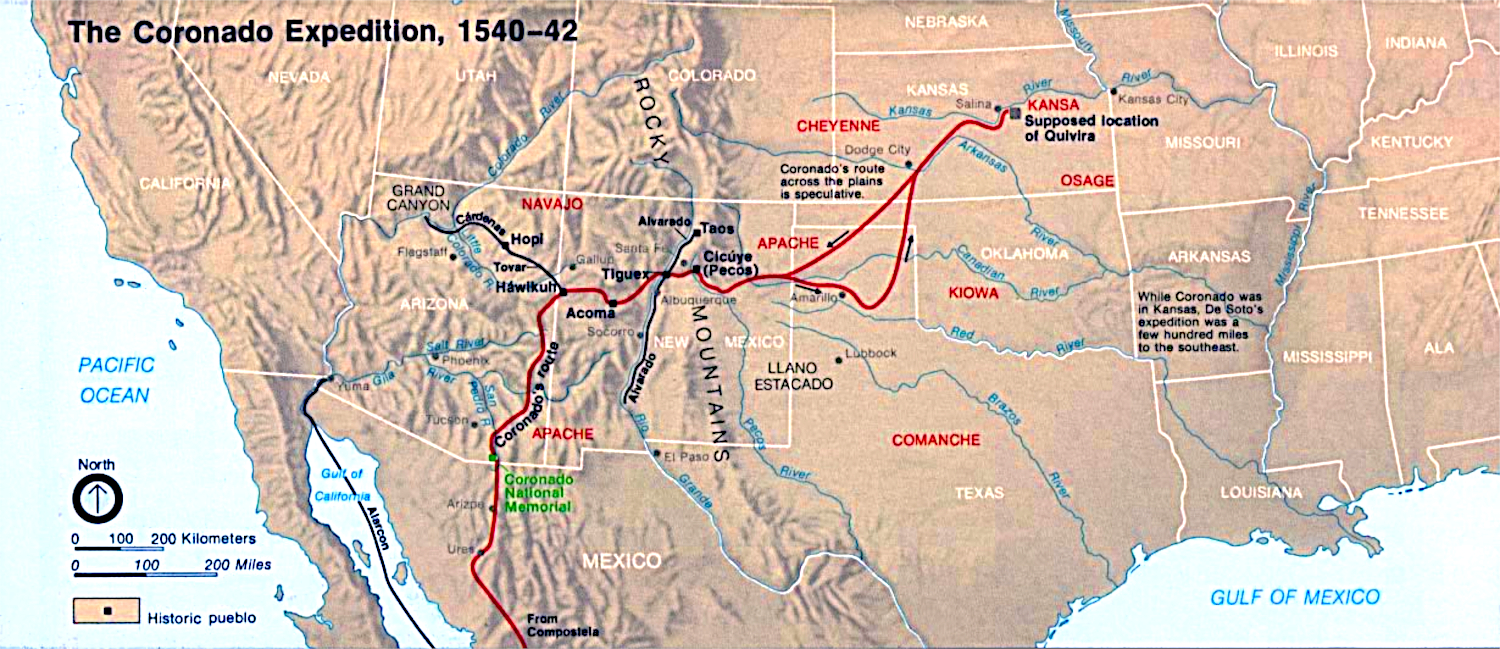
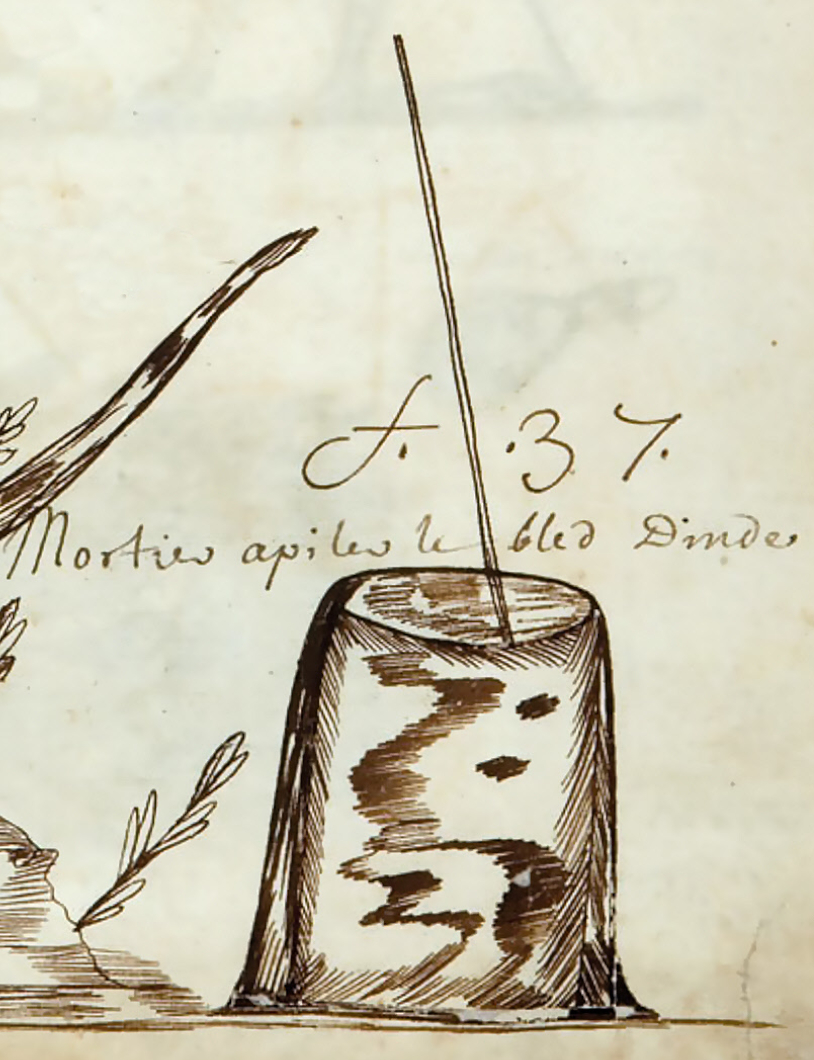
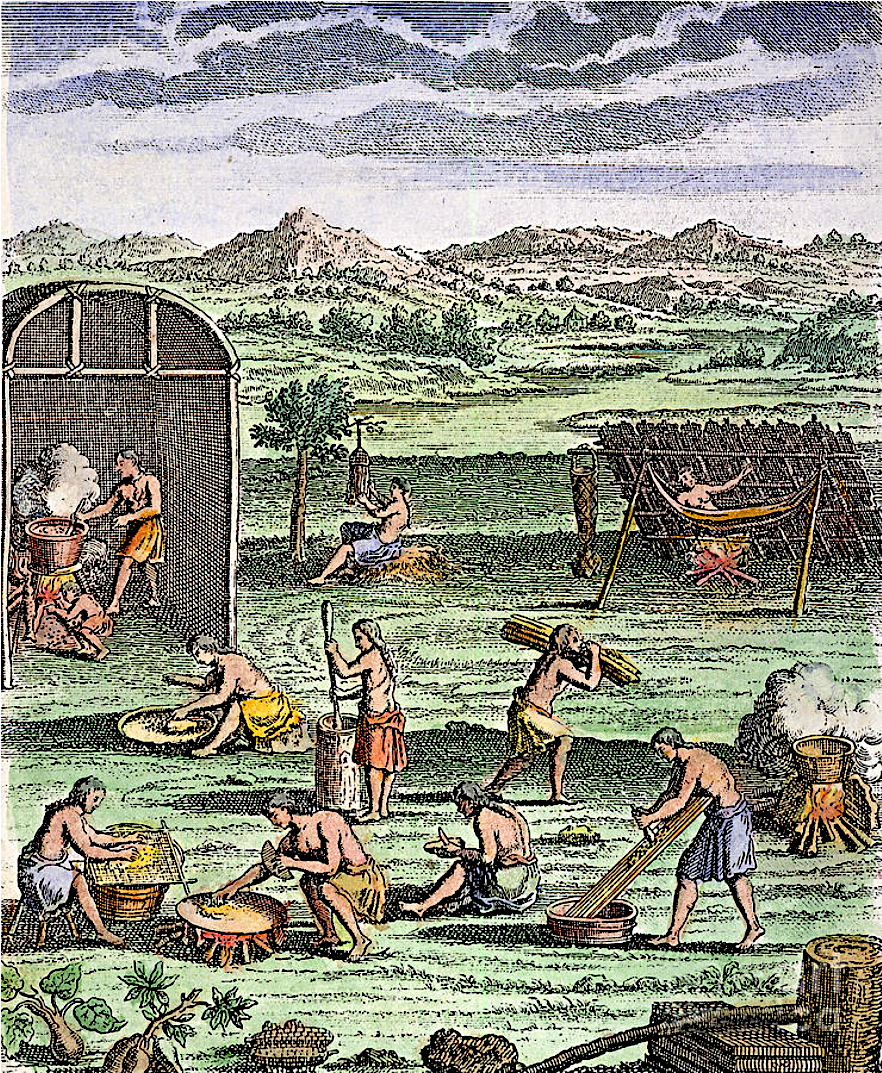
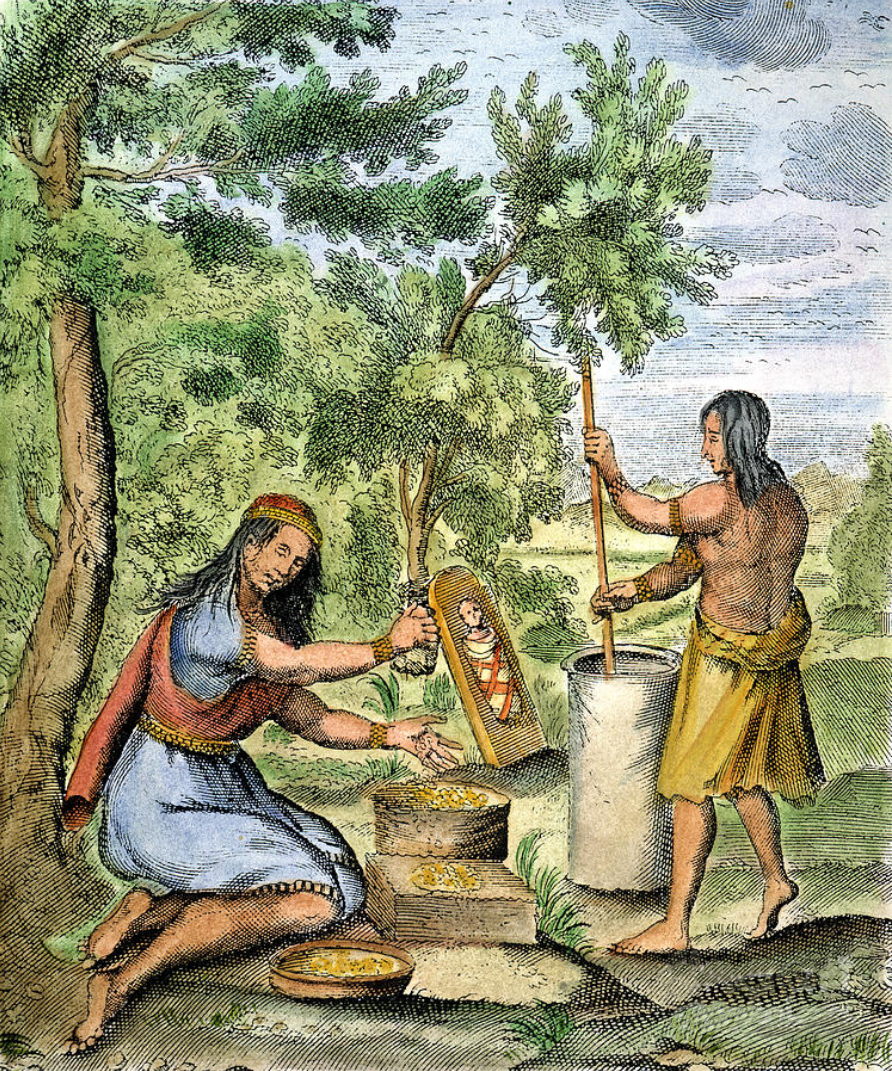

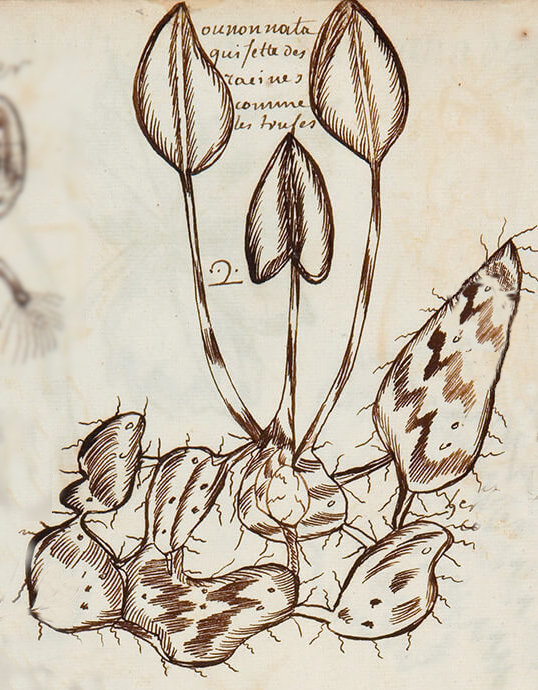
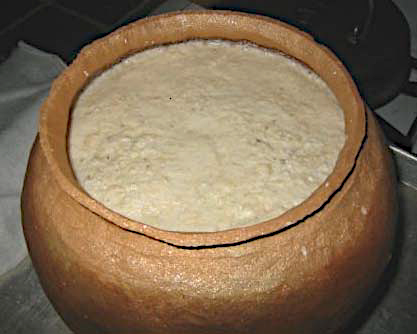
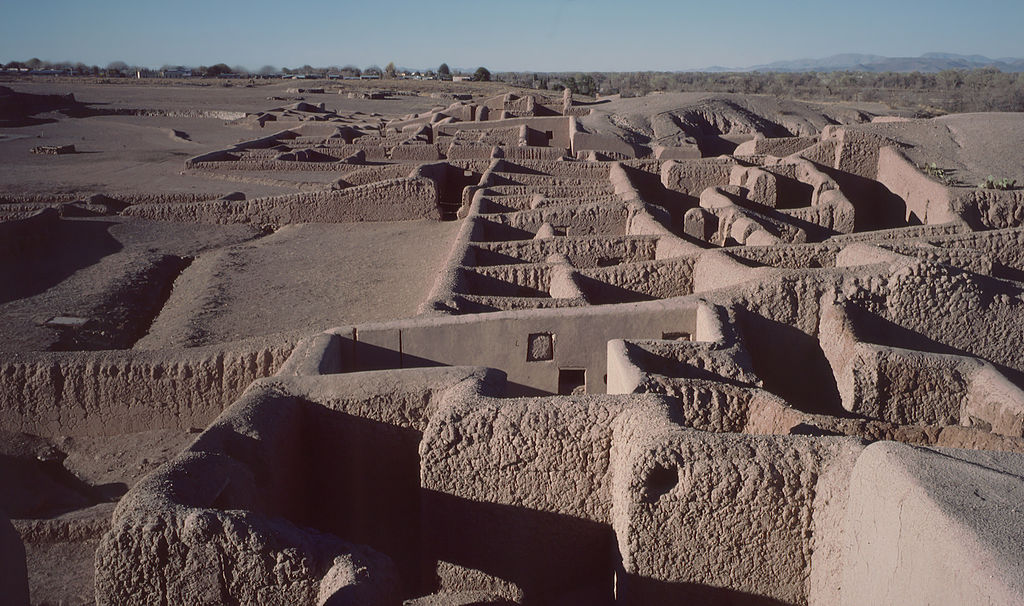


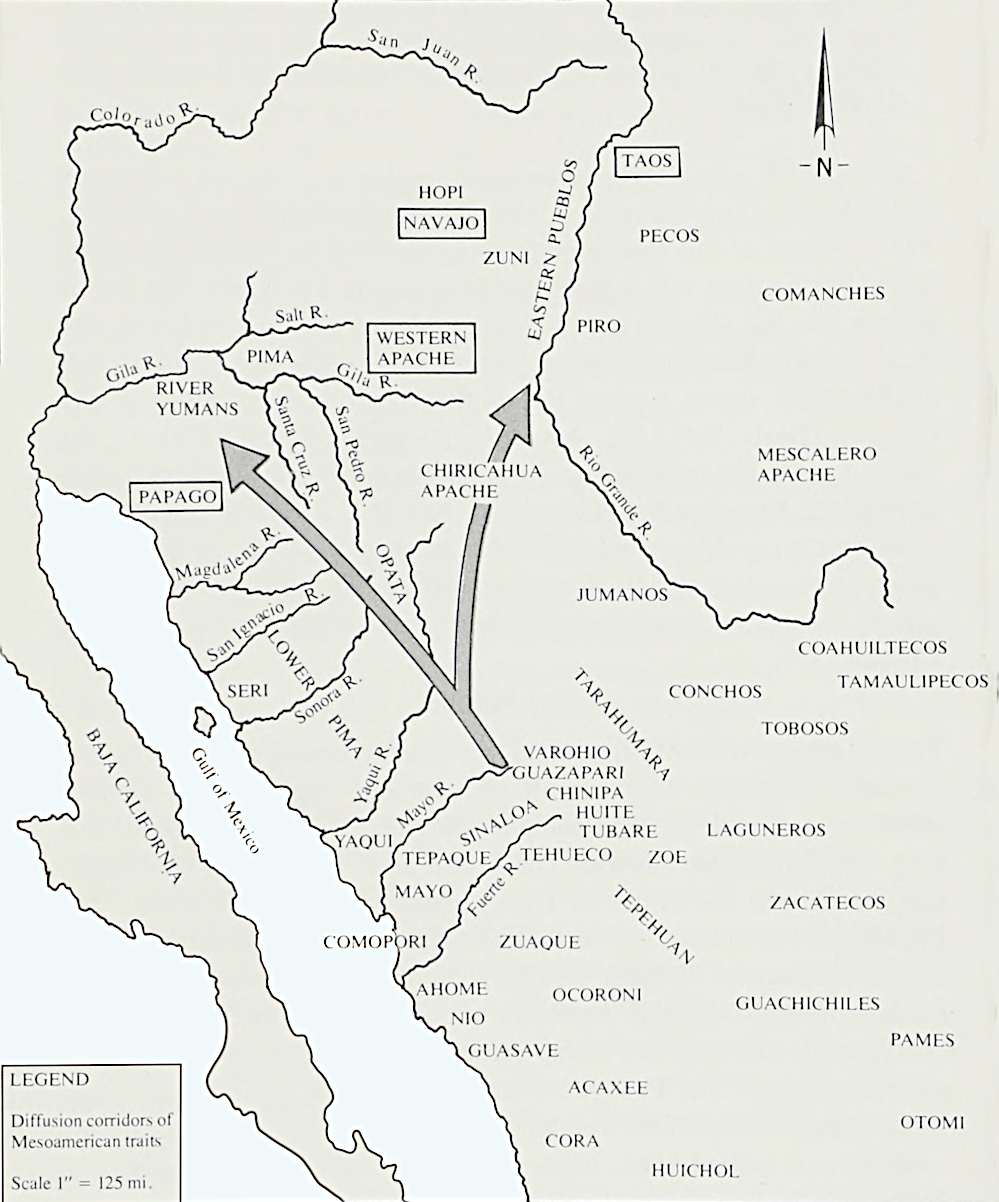
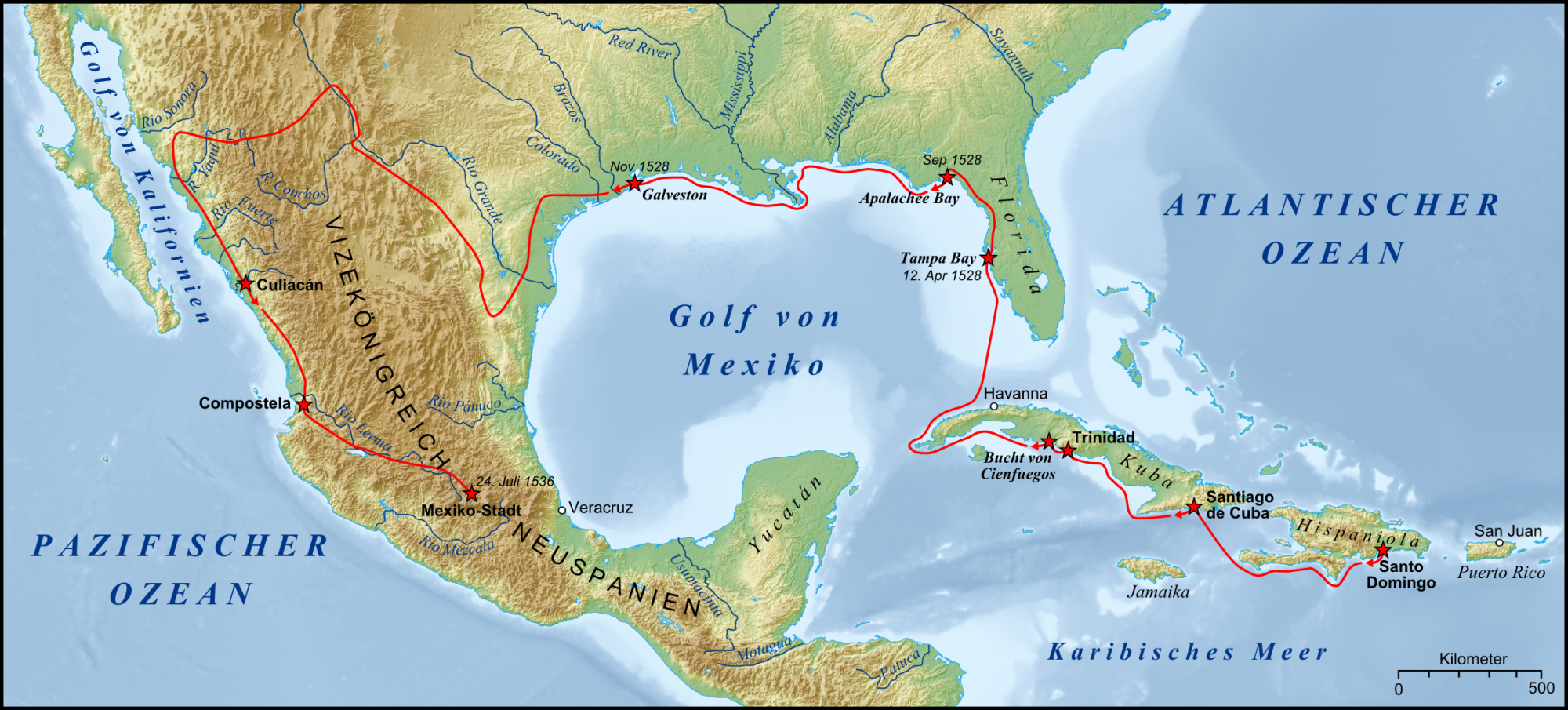
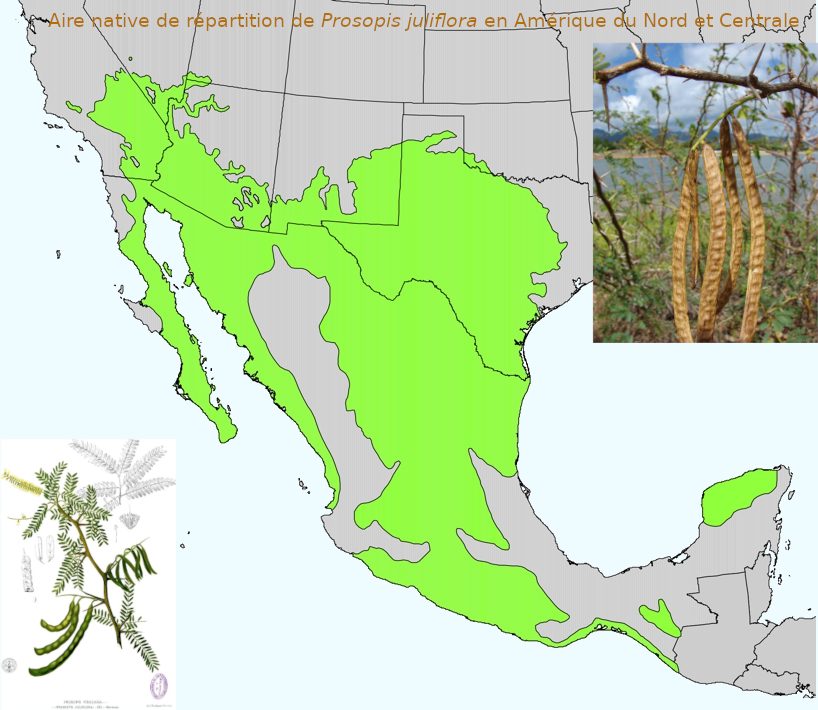
.jpg)

